MARIANI’S
Virtual Gourmet
December
2, 2018
NEWSLETTER
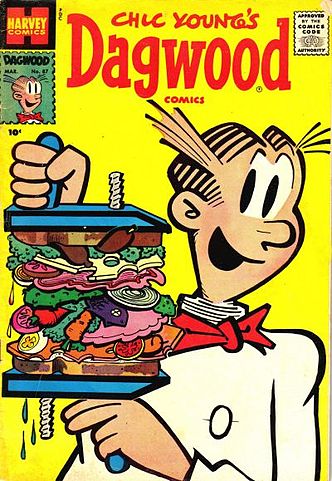
❖❖❖
IN THIS ISSUE
DINING OUT IN ST. LOUIS
Part One
By John Mariani
HOLIDAY GIFTS FOR THE GOURMET
By John Mariani
NEW YORK CORNER
NY Botanical Garden Train Show
then Lunch on Arthur Avenue
By John Mariani
NOTES FROM THE WINE CELLAR
JOEL GOTT WINES
By John Mariani
❖❖❖
DINING OUT IN ST. LOUIS
By John Mariani
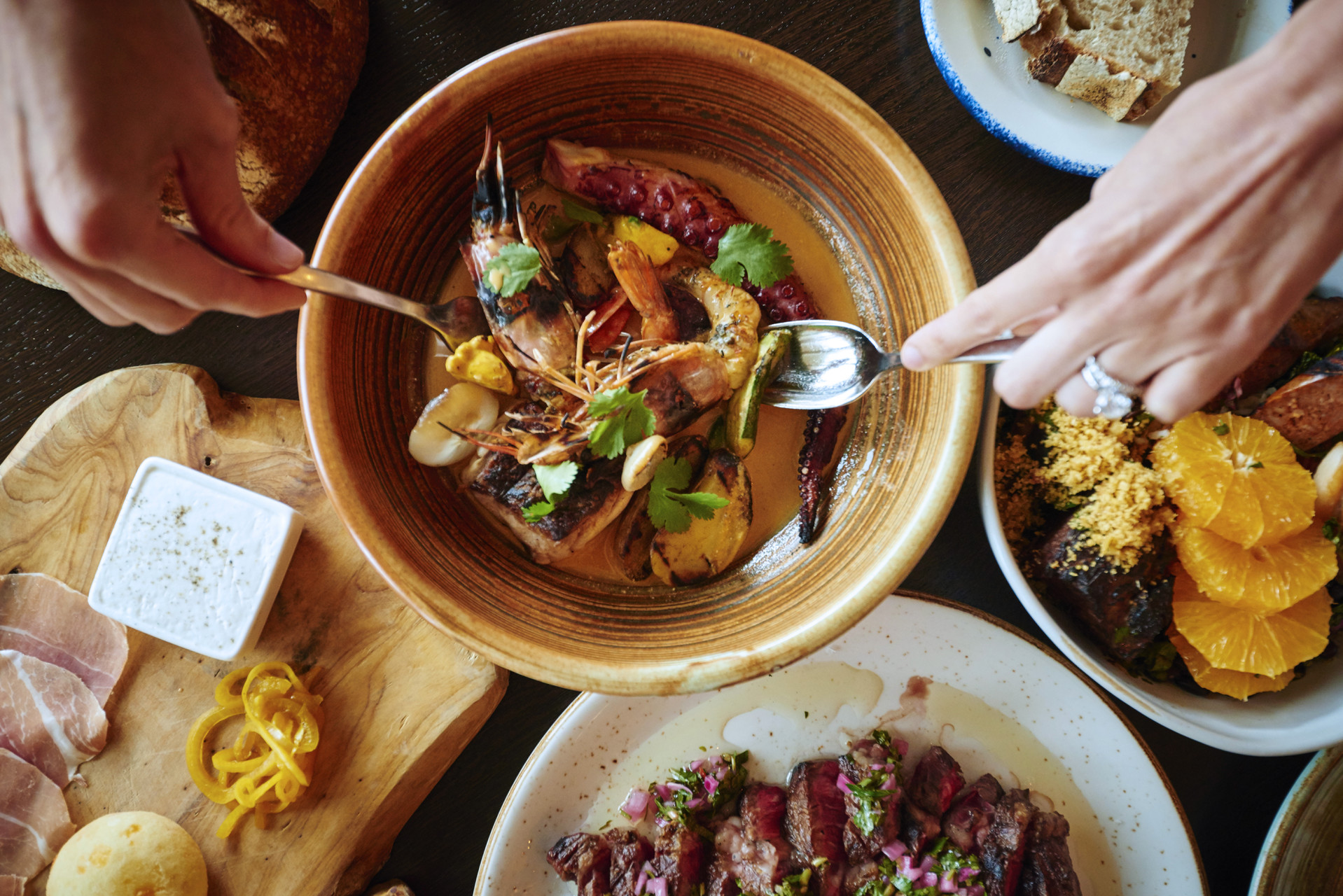
Cinder House
With only 318,00 residents St.
Louis has a vibrant dining scene that, as in
every American city, goes from high to low, from
posh to prole, and just about every ethnic
stripe can be found around town, not least near
the University and Delmar Loop. The area called
The Hill is still largely Italian-American, as
are the restaurants, and the casinos have added
the usual steakhouses and chain eateries.
There
are some overwrought restaurants like Vicia,
where a meal of bland mini-courses can go on for
hours, and Sidney Street Café, whose complicated
dishes are a drag in more ways than one. But
this week let me speak of the high side of the
city’s gastro-scape, one brand new, one as
revered as any in the Midwest.
Tony’s
410 Market St, St. Louis, MO
63102
314- 231-7007
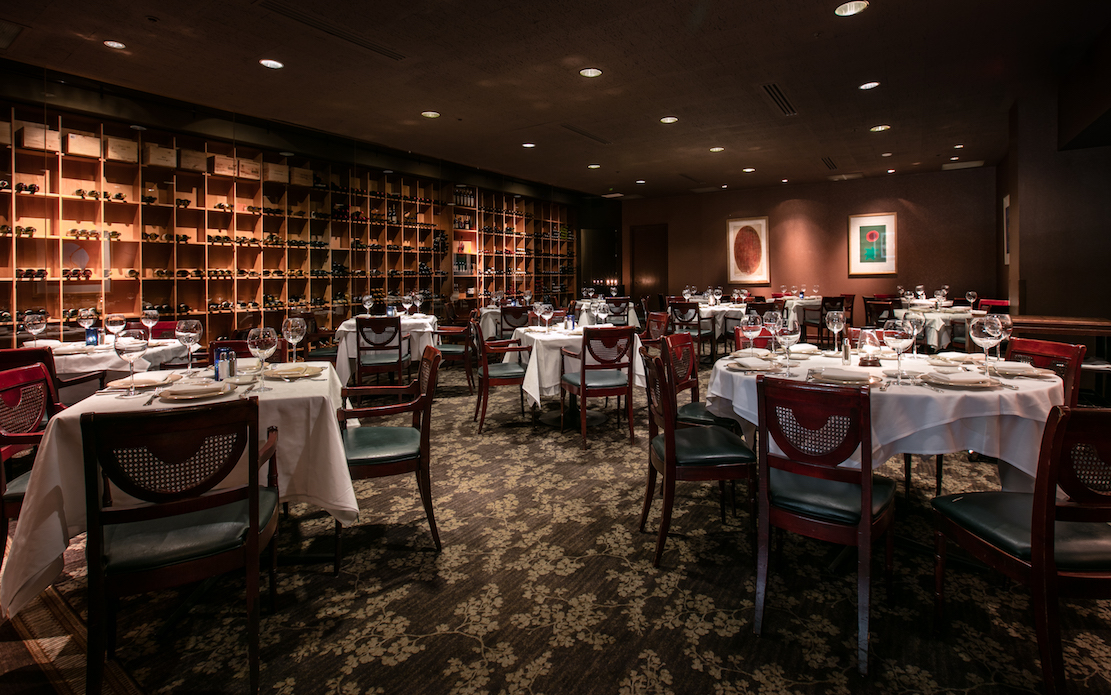
Two
of the finest restaurants in America are called
Tony’s—one in Houston owned by Tony Vallone, and
one in St. Louis owned by Vincent Bommarito and
his family, whose paterfamilias was named Tony.
Both restaurants are now better than ever in
their long histories.
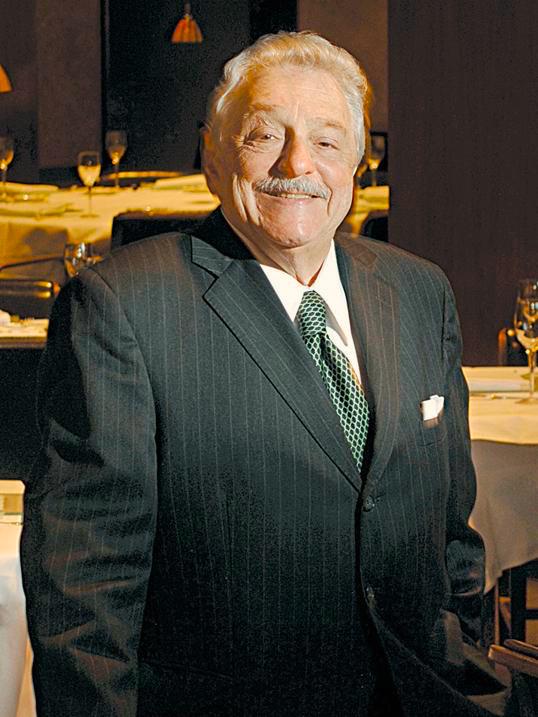 The St.
Louis Tony’s began as an Italian bakery, evolving
into a restaurant in 1946 as Tony’s Spaghetti
House, then Tony’s Steak House. Tony died in 1949,
but his son Vincent, just graduated from St. Louis University
High School, took over the operation as
“headwaiter,” with his sister as hostess. Today,
after many decorous changes and occasional shifts
of location, Tony’s thrives and Vince is still
there every day while his son James, along with a
cadre of long-standing staff (Ken
Bollewark
The St.
Louis Tony’s began as an Italian bakery, evolving
into a restaurant in 1946 as Tony’s Spaghetti
House, then Tony’s Steak House. Tony died in 1949,
but his son Vincent, just graduated from St. Louis University
High School, took over the operation as
“headwaiter,” with his sister as hostess. Today,
after many decorous changes and occasional shifts
of location, Tony’s thrives and Vince is still
there every day while his son James, along with a
cadre of long-standing staff (Ken
Bollewark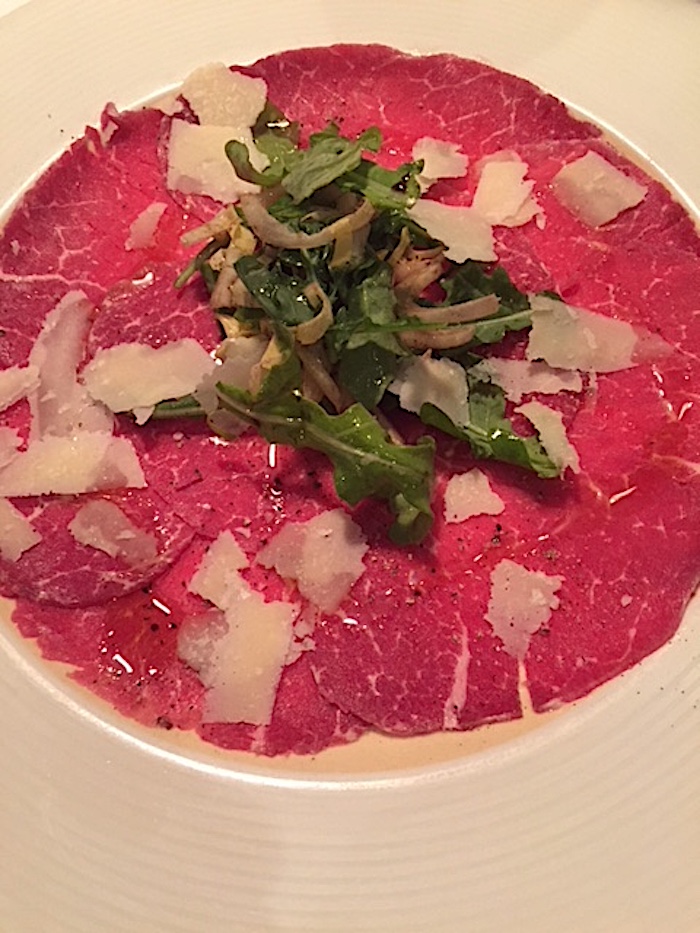 has been
manager of the dining room for more than 30 years)
has not just maintained the restaurants’ eminence
but continuously improved every aspect of food,
service and wine. The adjacent Anthony’s Bar
remains the city’s top power lunch.
has been
manager of the dining room for more than 30 years)
has not just maintained the restaurants’ eminence
but continuously improved every aspect of food,
service and wine. The adjacent Anthony’s Bar
remains the city’s top power lunch.
The
main dining room at Tony’s is stunning, with its
soft, civilized lighting, sound buffering and wall
of wines from around the globe. Tony’s has its own
butcher, Herbie Cray, and all the breads are made
on premises. The china and wineglasses are of
first quality, double tablecloths are soft and
thick, and there are even Sterling silver wine
holders that must weigh 50 pounds, salvaged from
the days of the great luxury liners. The dining
room staff exhibits the same sense of refinement
and manners as any great restaurant in the
U.S.—genteel, professional but with a welcome
sense of Midwestern hospitality. Vincent, as ever,
is a demanding but amiable presence who never
misses a fork out of place or the need for a new
napkin.
 I first
dined at Tony’s back in the 1980s and have never
found the restaurant to stand still. The menu
changes with the increase of better global
ingredients, seafood is flown in three times a
week and both old favorites (they still use the
original meatball recipe) share space with along
with dishes like seared sea scallops with black
truffles ($15), fettuccine with duck confit and
wild mushrooms ($16), and chicken with black
olives, grapefruit and fennel ($24). I recently
enjoyed one of the finest renditions of beef
carpaccio with arugula and truffle oil ($15) I’ve
ever had.
I first
dined at Tony’s back in the 1980s and have never
found the restaurant to stand still. The menu
changes with the increase of better global
ingredients, seafood is flown in three times a
week and both old favorites (they still use the
original meatball recipe) share space with along
with dishes like seared sea scallops with black
truffles ($15), fettuccine with duck confit and
wild mushrooms ($16), and chicken with black
olives, grapefruit and fennel ($24). I recently
enjoyed one of the finest renditions of beef
carpaccio with arugula and truffle oil ($15) I’ve
ever had.
There are seven pastas, four cheeses, seasonal
specials and tableside-prepared desserts,
including warm zabaglione over strawberries ($13)
and bananas
flambé ($13), all accompanied by a stellar
list of trophy wines, small vintners and many
bottles under $70.
If
you want to know what drives Tony’s and keeps it
at the top of St. Louis dining, ask if you can go
into the kitchen.
There, on one wall is a very large sign,
with one word: PRIDE. And there’s your answer.
Open
for dinner Mon.-Sat.
Cinder House
Four Seasons Hotel
999 North Second Street
314-881-5600
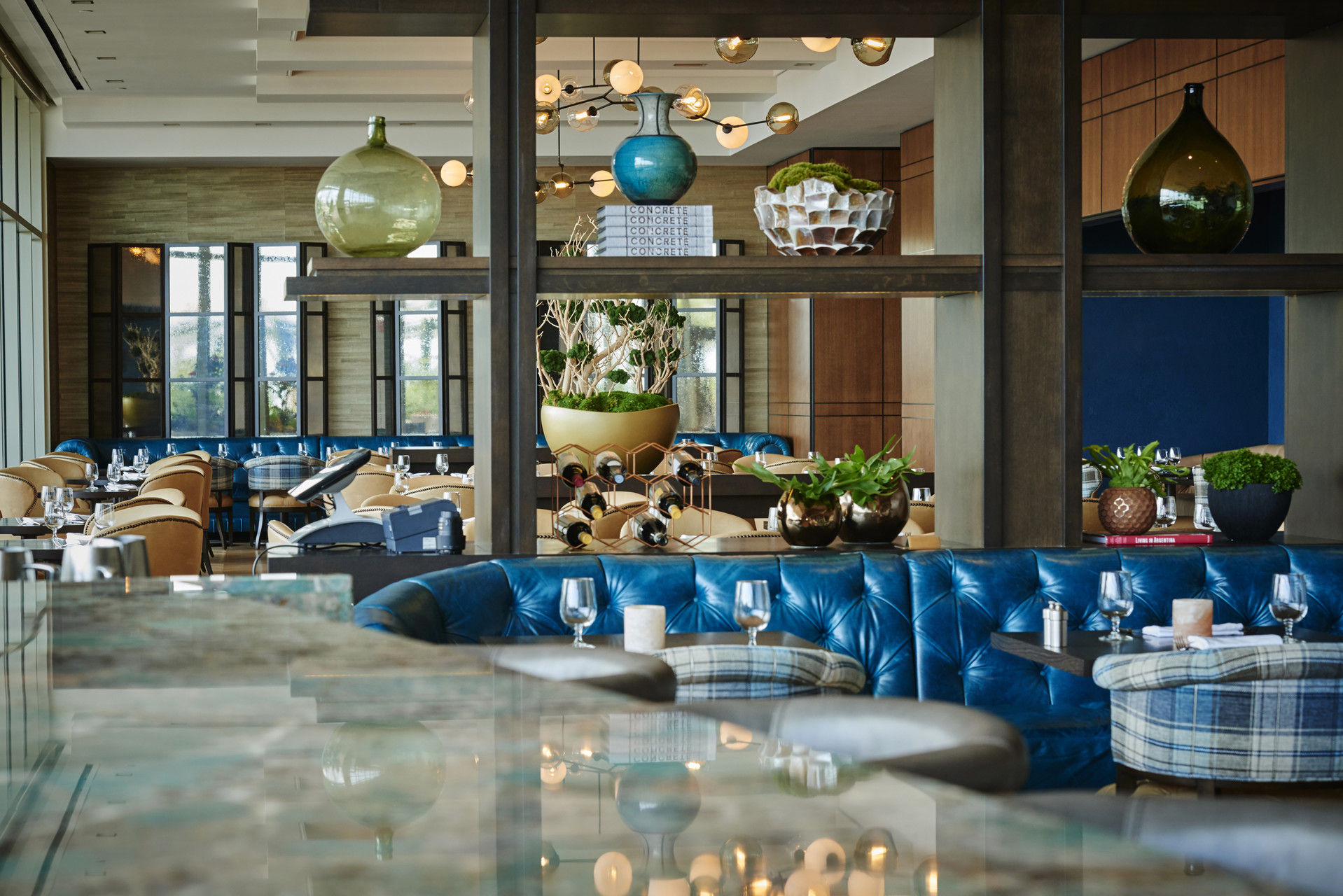
The
Four Seasons Hotel, connected to the Casino, has
the chain’s requisite posh, but now it has one
of the city’s most exciting—and quite
unexpected—restaurants. Cinder House is a leap
of faith, for this is an upscale South American
restaurant by James Beard Award-Winning
Chef Gerard Craft using wood-fired meat
techniques to cook his food, and the results are
unlike any I’ve had outside of Chicago in the
Midwest.
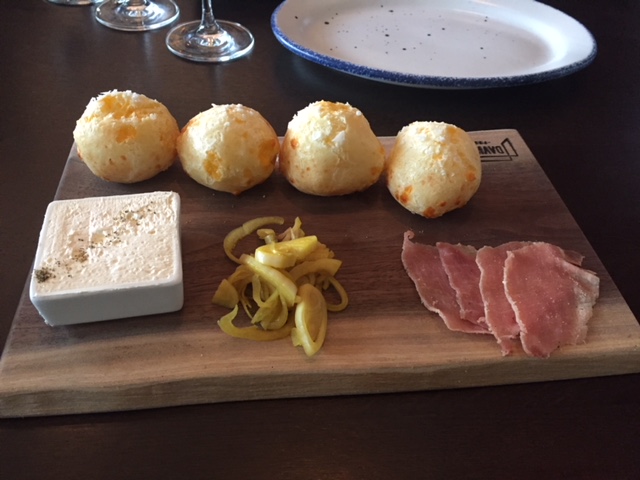 Craft is executive chef
and owner of Niche Food Group in St. Louis, now
with four restaurants: Taste by Niche, Brasserie by
Niche, Pastaria, and Sardella. Cinder House,
opened late last year, draws on his local
celebrity and Craft, working with exec-sous- chef
Michael Fricker and drawing on Craft’s memories of
his Brazilian nanny named Dia, who taught him how
to make dishes like feijoada ($32), the traditional black bean
stew chock full of pork and sausage, braised beef,
kale and chimichurri (below). I’ve had muddy messes
called feijoada, but Cinder House’s version is as
delicious as it gets.
Craft is executive chef
and owner of Niche Food Group in St. Louis, now
with four restaurants: Taste by Niche, Brasserie by
Niche, Pastaria, and Sardella. Cinder House,
opened late last year, draws on his local
celebrity and Craft, working with exec-sous- chef
Michael Fricker and drawing on Craft’s memories of
his Brazilian nanny named Dia, who taught him how
to make dishes like feijoada ($32), the traditional black bean
stew chock full of pork and sausage, braised beef,
kale and chimichurri (below). I’ve had muddy messes
called feijoada, but Cinder House’s version is as
delicious as it gets.
You
begin
here with pão
de queijo ($12), an irresistible, puffy
cheese bread made with tapioca flour (left), and the
appetizers include succulent lamb ribs ($16) with
soy, lime and mango honey—kind of daring for a
bar-b-q rich town like St. Louis. Piri piri
chicken ($28) has assertive spicing and seasoning,
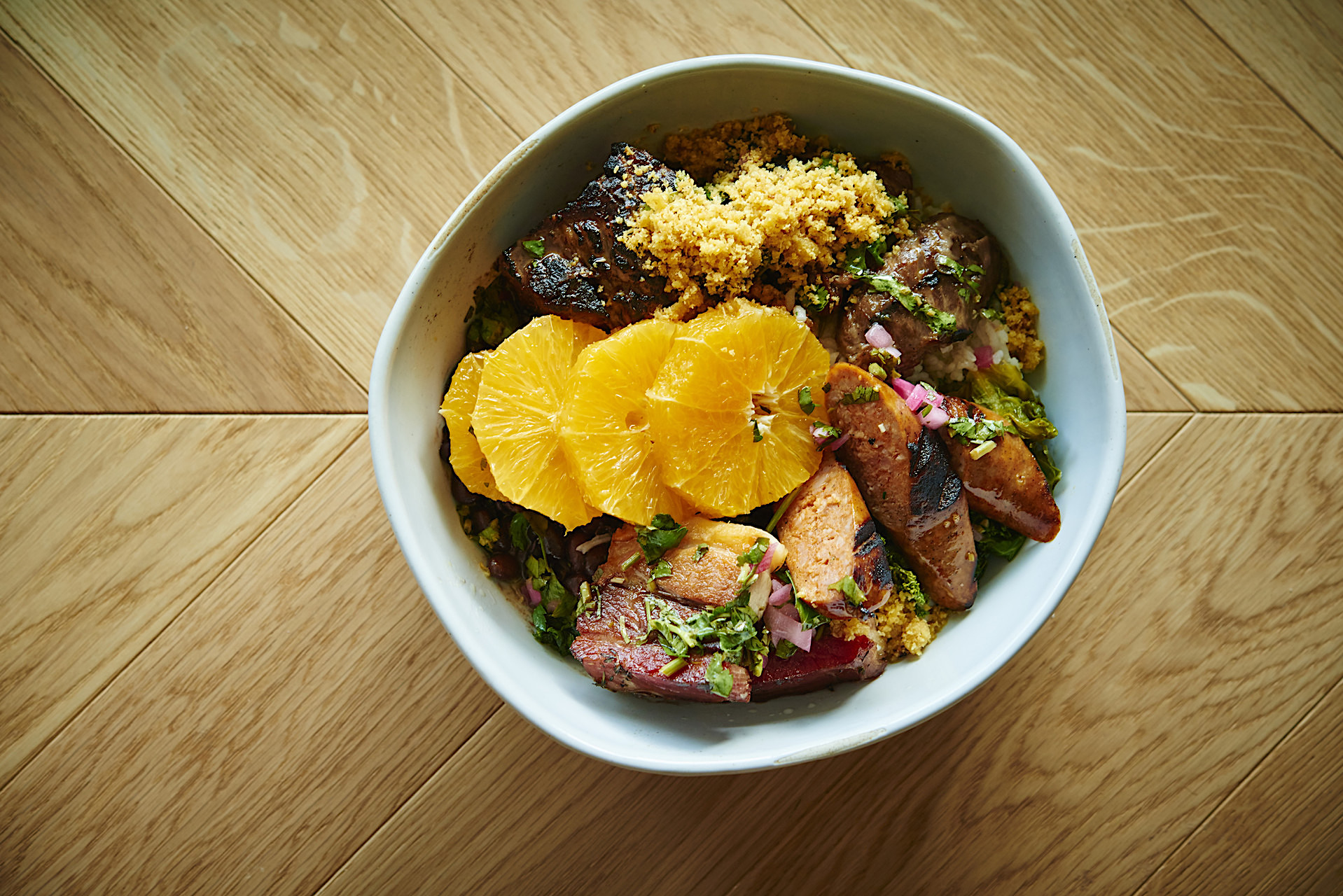 along with
manioc polenta and grilled scallions, while moqueca ($30)
is
a seafood variant on feijoada—snapper,
prawns,
octopus and lobster in a coconut milk broth with
fingerling potatoes confit and vegetables.
along with
manioc polenta and grilled scallions, while moqueca ($30)
is
a seafood variant on feijoada—snapper,
prawns,
octopus and lobster in a coconut milk broth with
fingerling potatoes confit and vegetables.
Of course there are wood-fired steaks—four cuts,
from $36 for a bavette to a $56 16-ounce
ribeye—and although you really don’t need side
dishes, you’ll love the potato puree with olive
oil and thyme ($9) and the leeks with crème
fraîche and “house fry sauce” ($9).
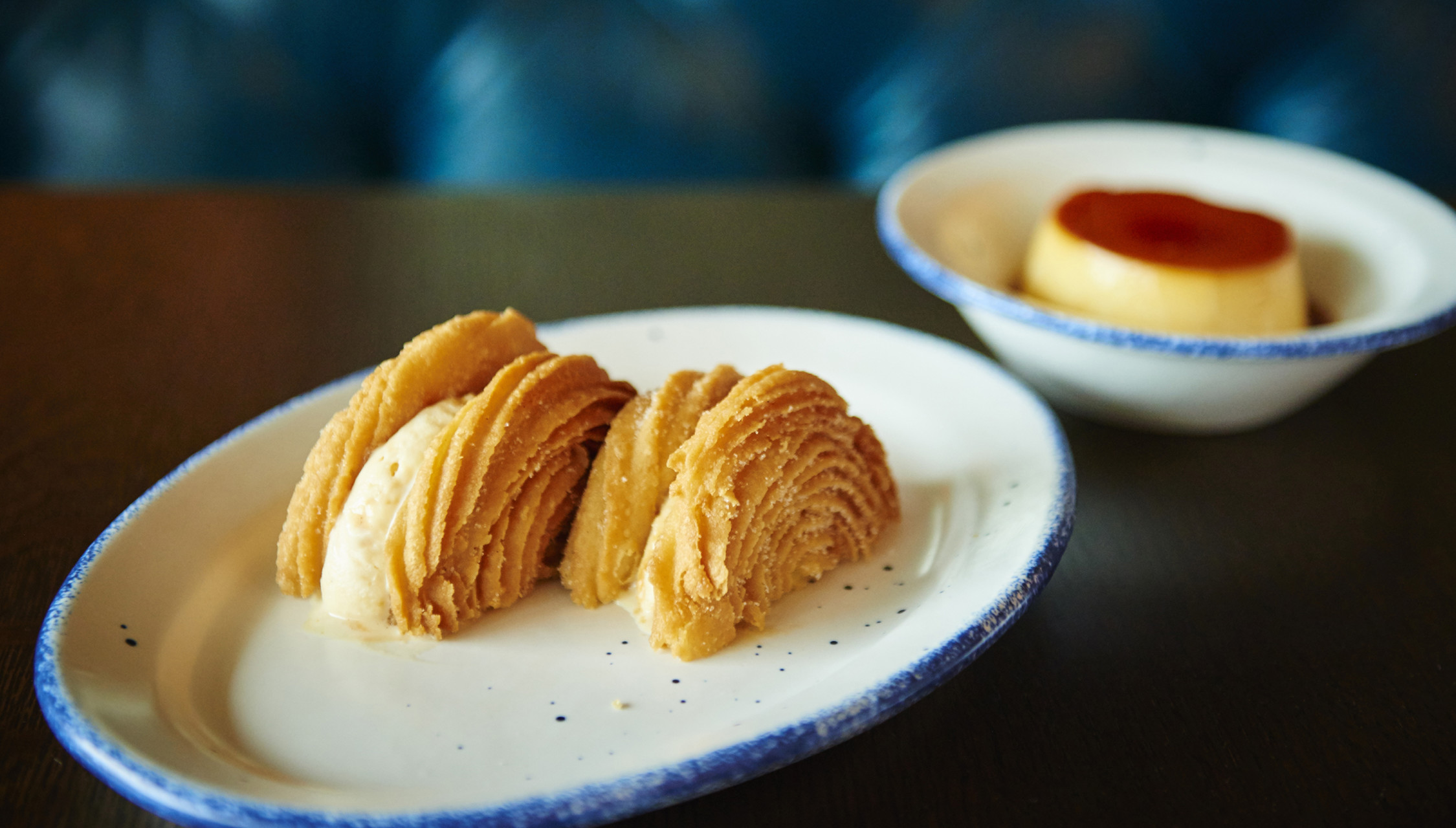 In style and substance
Cinder House scores equally with desserts like a
traditional flan ($9), a churro
fritter ice cream sandwich with goat’s cheese
($7), and a fabulous rice pudding with toasted
almonds, cinnamon streusel, caramel sauce and
strawberries.
In style and substance
Cinder House scores equally with desserts like a
traditional flan ($9), a churro
fritter ice cream sandwich with goat’s cheese
($7), and a fabulous rice pudding with toasted
almonds, cinnamon streusel, caramel sauce and
strawberries.
The dining room itself is hotel large, with glass
walls overlooking the patio and bar that
themselves overlook the Mississippi River, a good
spot to sip a caipiriñha cocktail made with
Brazilian rum.
Inside,
coffee-colored leather chairs and blue tufted
banquettes soften the hovering high ceiling and
tables devoid of cloths, which seems more fit for
breakfast than dinner.
Cinder
House adds measurably to the St. Louis dining
scene in a brilliantly novel way. In an upcoming
article I’ll write about the city’s down-home
fare, but there’s some real gastronomic clout in
this big Midwest town you don’t want to miss.
Open for
breakfast, lunch and dinner.
❖❖❖
HOLIDAY GIFTS FOR
THE GOURMET
By John Mariani
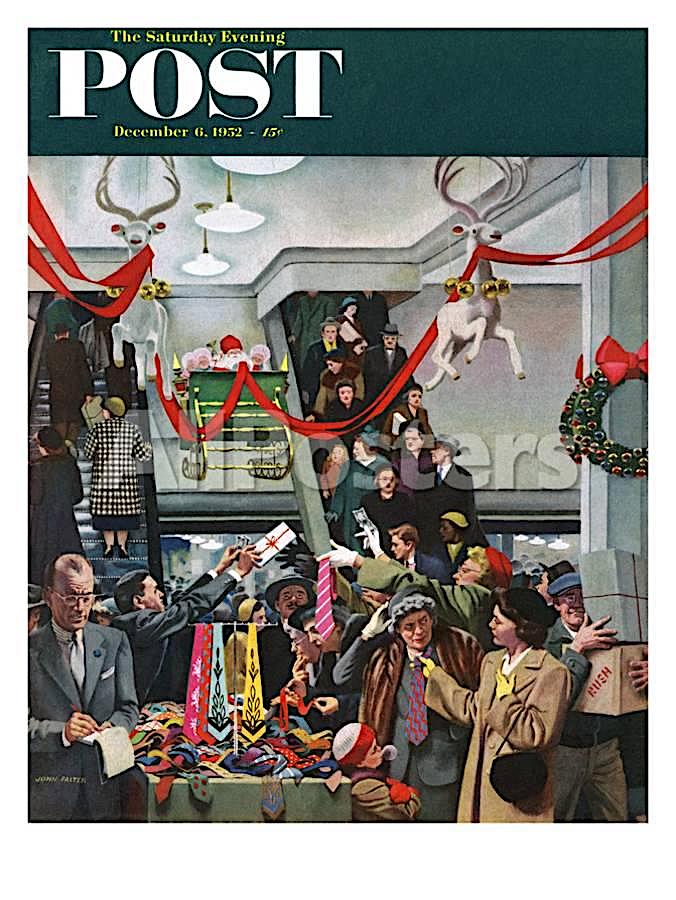
If it is indeed better to give than to receive, the best thing about giving gifts to gourmet friends is that there’s a good chance they will share them in one way or another—a dram of whiskey, a glass of wine, a recipe from a good cookbook. Here are some quite special items I can imagine your friends loving and using as soon as possible.
 MADE IN
COOKWARE—New lines of cookware appear
annually, but at my house, where my wife is the
Queen of the Kitchen, we still use an array of old
iron skillets for most of what we cook. But
testing out this new American-made (Austin, Texas)
line by Made In it surprised both of us for living
up to its claims. For one thing the stainless
steel is bonded five times with aluminum and an
alloy inside has a high nickel content that fights
rust and maintains the utensils’ shape, which
allows for a consistent, overall cooking surface.
The handles are designed for weight and balance,
and the Universal Lid ($42 on sale) is a fabulous
invention: made of
silicon-coated stainless steel, this one lid has
three different-size bottom lips, allowing it to
fit a variety of pots and pans without heat loss
and water run-off. And for the holidays they’ve
added a gold color to the line, and a gift any
cook would die for is their superb eight-inch
chef’s knife, made in France, hammered from a
single rod of nitrogen-treated, premium metal
(on sale for $76).
MADE IN
COOKWARE—New lines of cookware appear
annually, but at my house, where my wife is the
Queen of the Kitchen, we still use an array of old
iron skillets for most of what we cook. But
testing out this new American-made (Austin, Texas)
line by Made In it surprised both of us for living
up to its claims. For one thing the stainless
steel is bonded five times with aluminum and an
alloy inside has a high nickel content that fights
rust and maintains the utensils’ shape, which
allows for a consistent, overall cooking surface.
The handles are designed for weight and balance,
and the Universal Lid ($42 on sale) is a fabulous
invention: made of
silicon-coated stainless steel, this one lid has
three different-size bottom lips, allowing it to
fit a variety of pots and pans without heat loss
and water run-off. And for the holidays they’ve
added a gold color to the line, and a gift any
cook would die for is their superb eight-inch
chef’s knife, made in France, hammered from a
single rod of nitrogen-treated, premium metal
(on sale for $76).
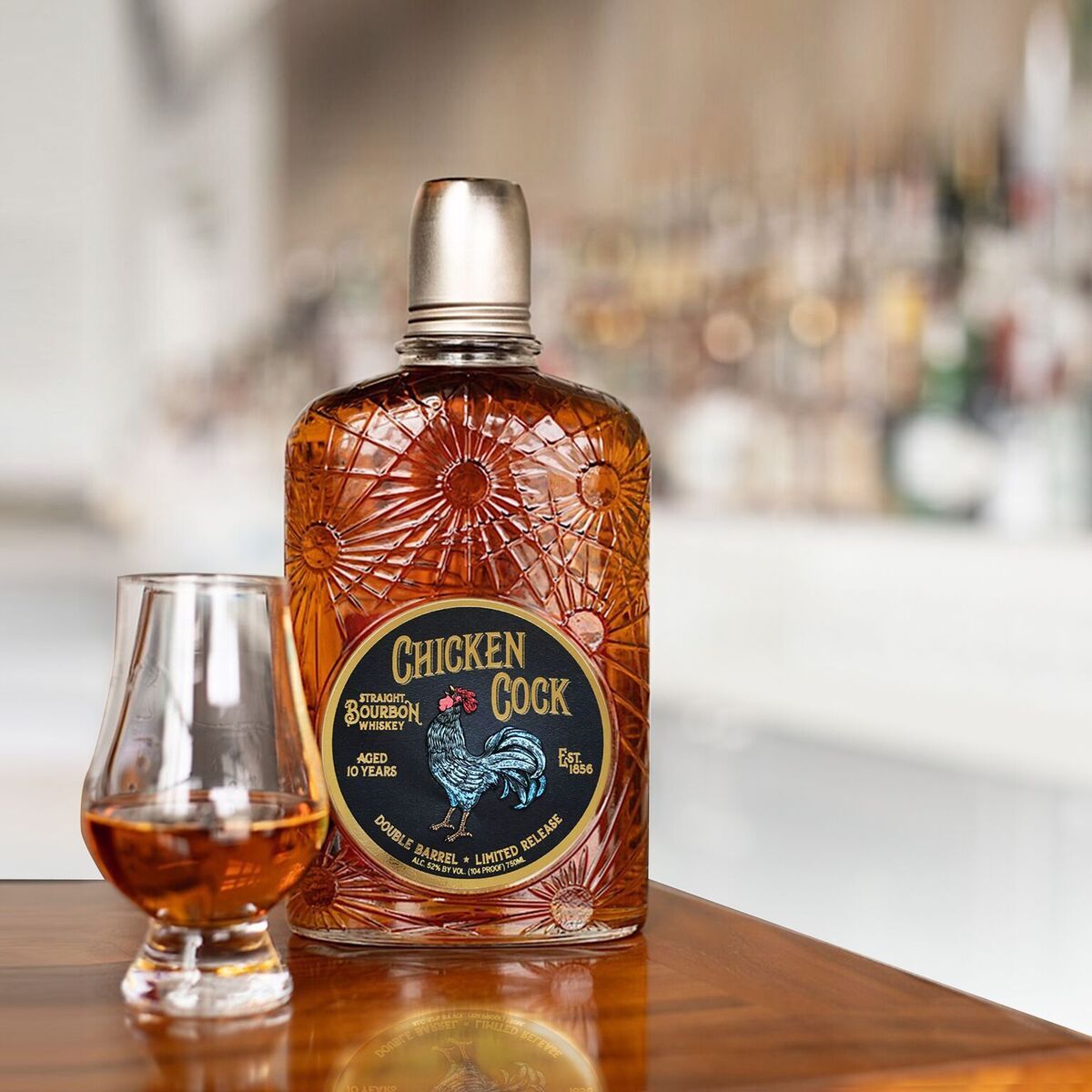
CHICKEN COCK DOUBLE
BARREL BOURBON ($250)—Chicken Cock’s history
goes back to 1856 and was famous during
Prohibition for being smuggled into Harlem’s
Cotton Club in tin cans. A hundred years after its
founding, the distillery burned to the ground, but
this re-incarnation by Grain & Barrel Spirits
of a bourbon selected from 12 barrels of
ten-year-olds comes out at 104 proof, non-chill
filtered. You can buy the brand’s other bottlings
from $38 to $99, but this one was limited to 1,980
bottles.
GLENDALOUGH MIZUNARA FINISH SINGLE
MALT IRISH WHISKEY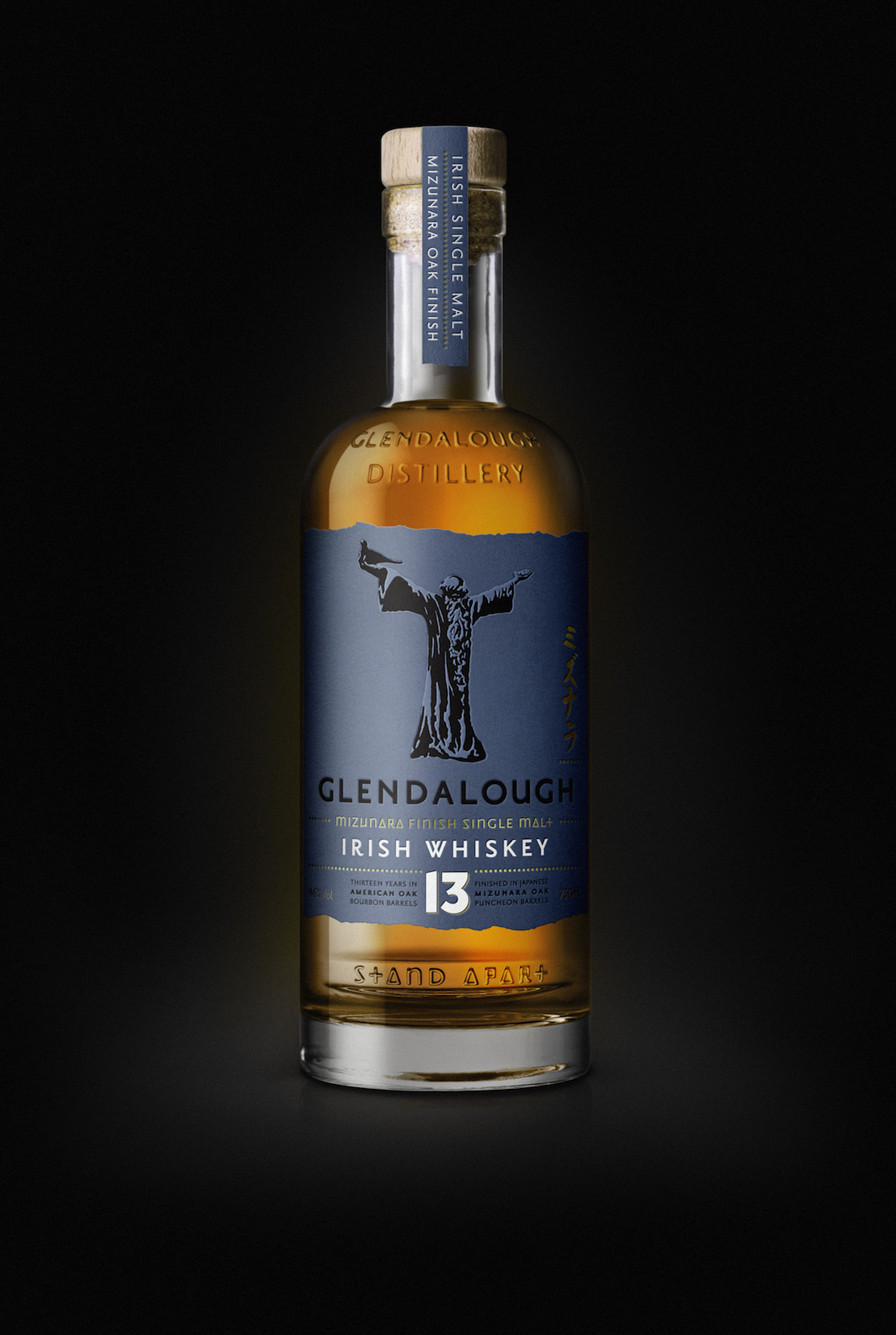 13 ($110-$120)—Odd, isn’t it, that
Japanese whiskeys have gained so much repute over
the past five years that European distilleries now
look to Japan for inspiration. In the
case of Glendalough’s Irish whiskey, the single
malt spirit was aged in bourbon barrels for 13
years then finished in Mizunara oak puncheon
barrels that mellow out the whiskey and give it
vanilla, coffee, honeyed notes. Apparently
Mizunara oaks in Hokkaido are an expensive rarity
and have to be 200 years old before conversion
into an aging barrel. The whiskey emerges at 46%
alcohol. This is not an Irish whiskey your friend
is liable to have on his shelf, so it will make an
excellent gift.
13 ($110-$120)—Odd, isn’t it, that
Japanese whiskeys have gained so much repute over
the past five years that European distilleries now
look to Japan for inspiration. In the
case of Glendalough’s Irish whiskey, the single
malt spirit was aged in bourbon barrels for 13
years then finished in Mizunara oak puncheon
barrels that mellow out the whiskey and give it
vanilla, coffee, honeyed notes. Apparently
Mizunara oaks in Hokkaido are an expensive rarity
and have to be 200 years old before conversion
into an aging barrel. The whiskey emerges at 46%
alcohol. This is not an Irish whiskey your friend
is liable to have on his shelf, so it will make an
excellent gift.
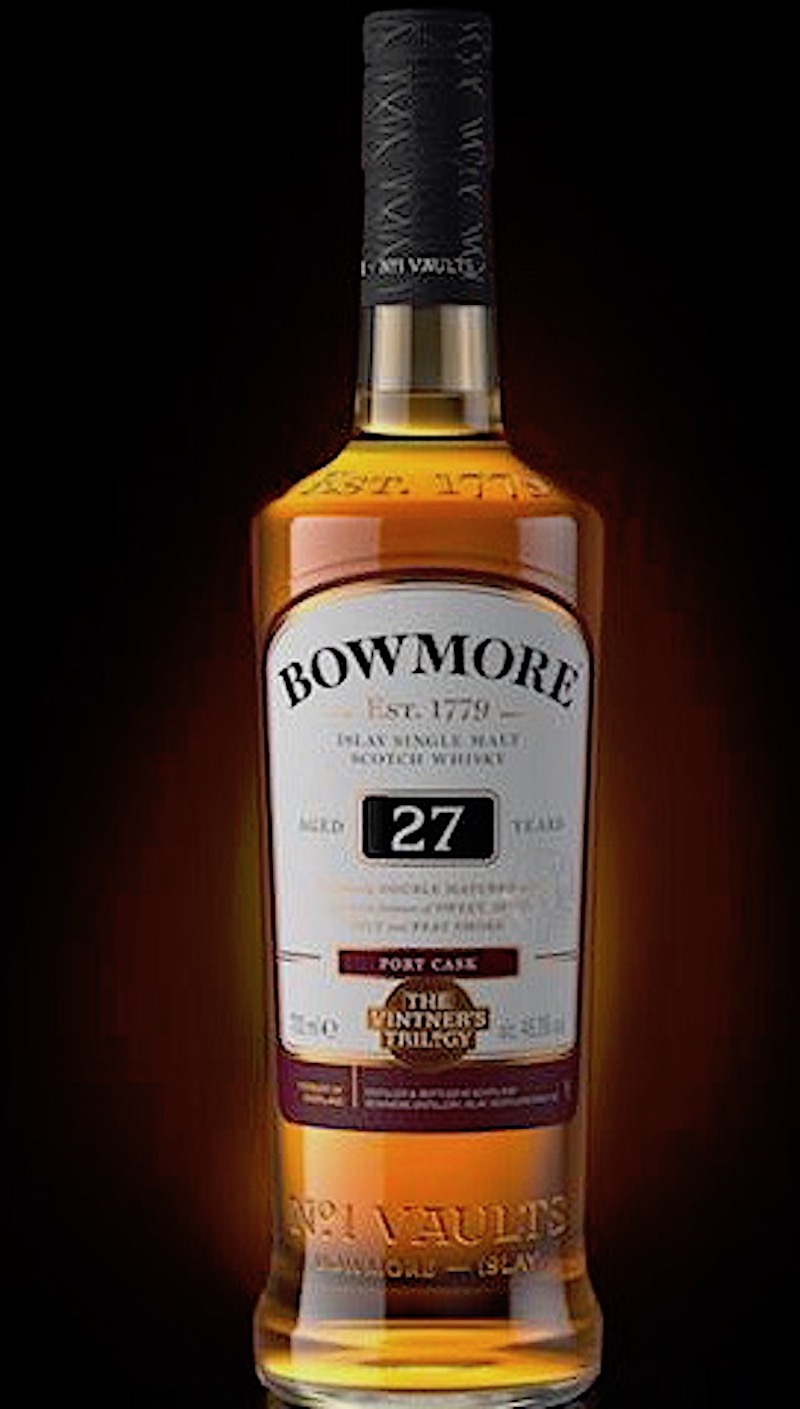 BOWMORE VINTNER’S
TRILOGY 27 YEAR OLD PORT CASK FINISH ($520)— At
this
price the person you give this superb Single
Malt Scotch had better share it
with you, and often. This limited edition
is the third, and for now,
final expression Bowmore’s Whisky Vintner’s
Trilogy matured twice at their No.
1 Vaults. It is first aged for 13 years in
ex-bourbon barrels, then for 14
years in Port pipes. It is non-chill filtered
and bottled at cask strength,
48.3% There’s a definite caramel undertow on its
way to a very smooth finish,
offering up complex layers of nuttiness, nutmeg
and an ideal amount of
smokiness for an Islay. (By the way, you can
find it for less than the listed
price above.)
BOWMORE VINTNER’S
TRILOGY 27 YEAR OLD PORT CASK FINISH ($520)— At
this
price the person you give this superb Single
Malt Scotch had better share it
with you, and often. This limited edition
is the third, and for now,
final expression Bowmore’s Whisky Vintner’s
Trilogy matured twice at their No.
1 Vaults. It is first aged for 13 years in
ex-bourbon barrels, then for 14
years in Port pipes. It is non-chill filtered
and bottled at cask strength,
48.3% There’s a definite caramel undertow on its
way to a very smooth finish,
offering up complex layers of nuttiness, nutmeg
and an ideal amount of
smokiness for an Islay. (By the way, you can
find it for less than the listed
price above.)
PIERRE FERRAND SELECTION DES ANGES
($150)—Cognac has been
somewhat out of the 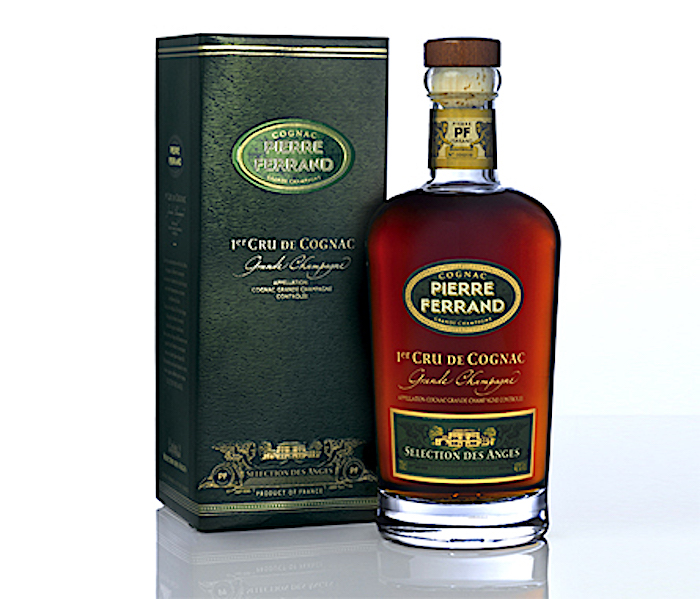 limelight
since the emergence of the single malts and
bourbon phenomenon of the last decade, but this
beautiful 30-year-old Cognac
should be on every connoisseur’s shelf of fine
spirits. The eaux de vie used
are all from the 1st Cru de
Cognac, specifically the Grande
Champagne Cognac appellation, known as the
“Golden Triangle.” The name “des anges”
refers
to the so-called “angel’s share” of Cognac that
evaporates through the barrels
as it ages. The bouquet is subtle with flowers,
and immediately on the palate
there is a burst of elegant flavors, leathery,
toasty, full of herbs and
spices, a lovely expression of how Cognac is its
own distinctive spirit.
limelight
since the emergence of the single malts and
bourbon phenomenon of the last decade, but this
beautiful 30-year-old Cognac
should be on every connoisseur’s shelf of fine
spirits. The eaux de vie used
are all from the 1st Cru de
Cognac, specifically the Grande
Champagne Cognac appellation, known as the
“Golden Triangle.” The name “des anges”
refers
to the so-called “angel’s share” of Cognac that
evaporates through the barrels
as it ages. The bouquet is subtle with flowers,
and immediately on the palate
there is a burst of elegant flavors, leathery,
toasty, full of herbs and
spices, a lovely expression of how Cognac is its
own distinctive spirit.
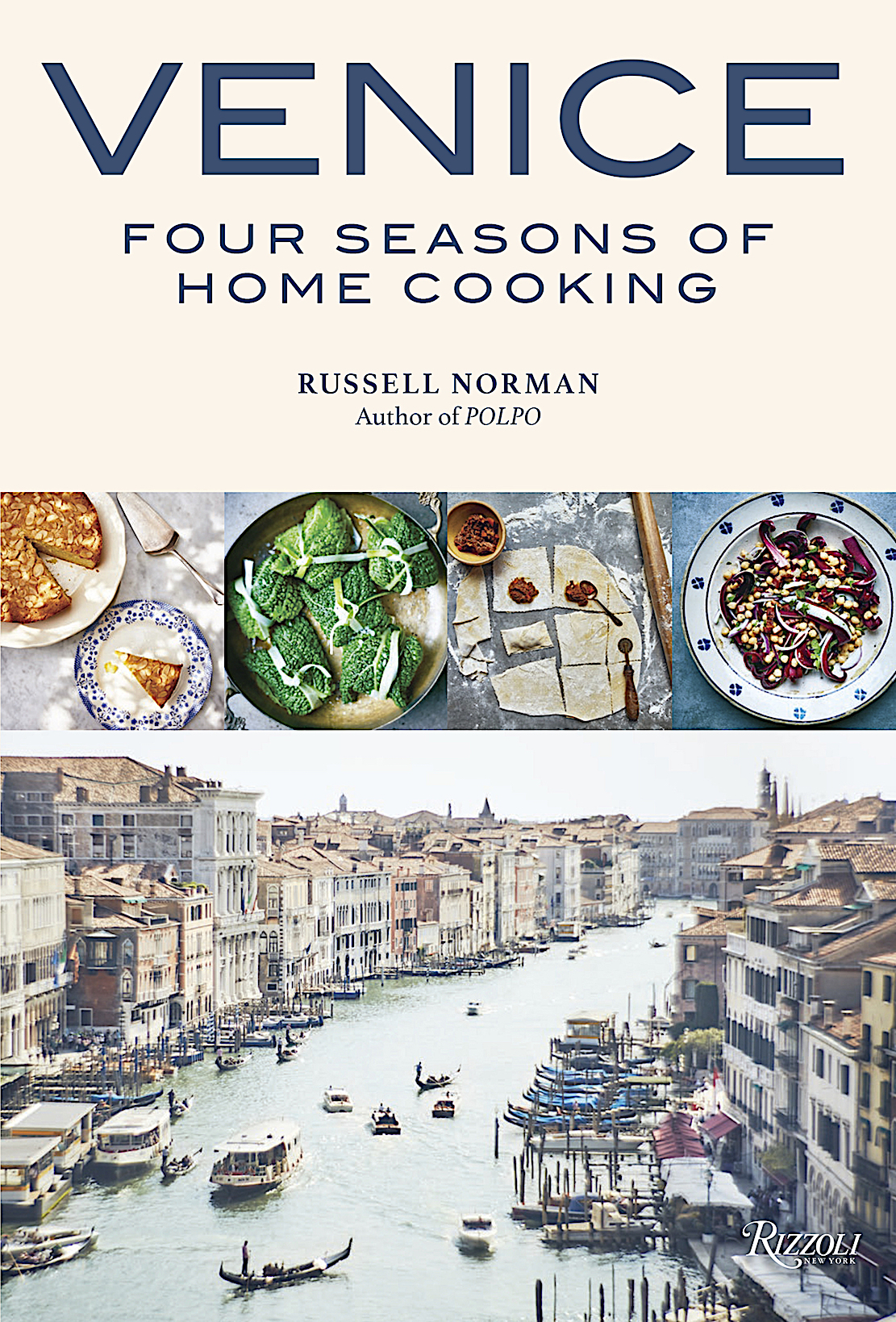
VENICE: FOUR SEASONS OF HOME COOKING By Russell Norman
($40)—Sometimes, though rarely, it takes a
non-Italian to break from entrenched stereotypes
about Italian food, and Russell Norman, founder of
the POLPO restaurant group in London, has done so
with a seasonal cookbook of recipes actually made
at home, not based on ristorante dishes (no
carpaccio here). So you get simple, savory dishes
like spaghetti with sweet onions, grilled polenta
with chopped olives and anchovies, warm radicchio,
pancetta and chickpea salad and Venetian donuts
called fritole.
The publisher Rizzoli uses second-rate paper that,
oddly enough, gives the photos a kind of misty
Venetian look that is actually evocative.
MODERN GREEK COOKING By Pano Karatassos ($37.50)—Pano
Karatossos Sr., is one of America’s 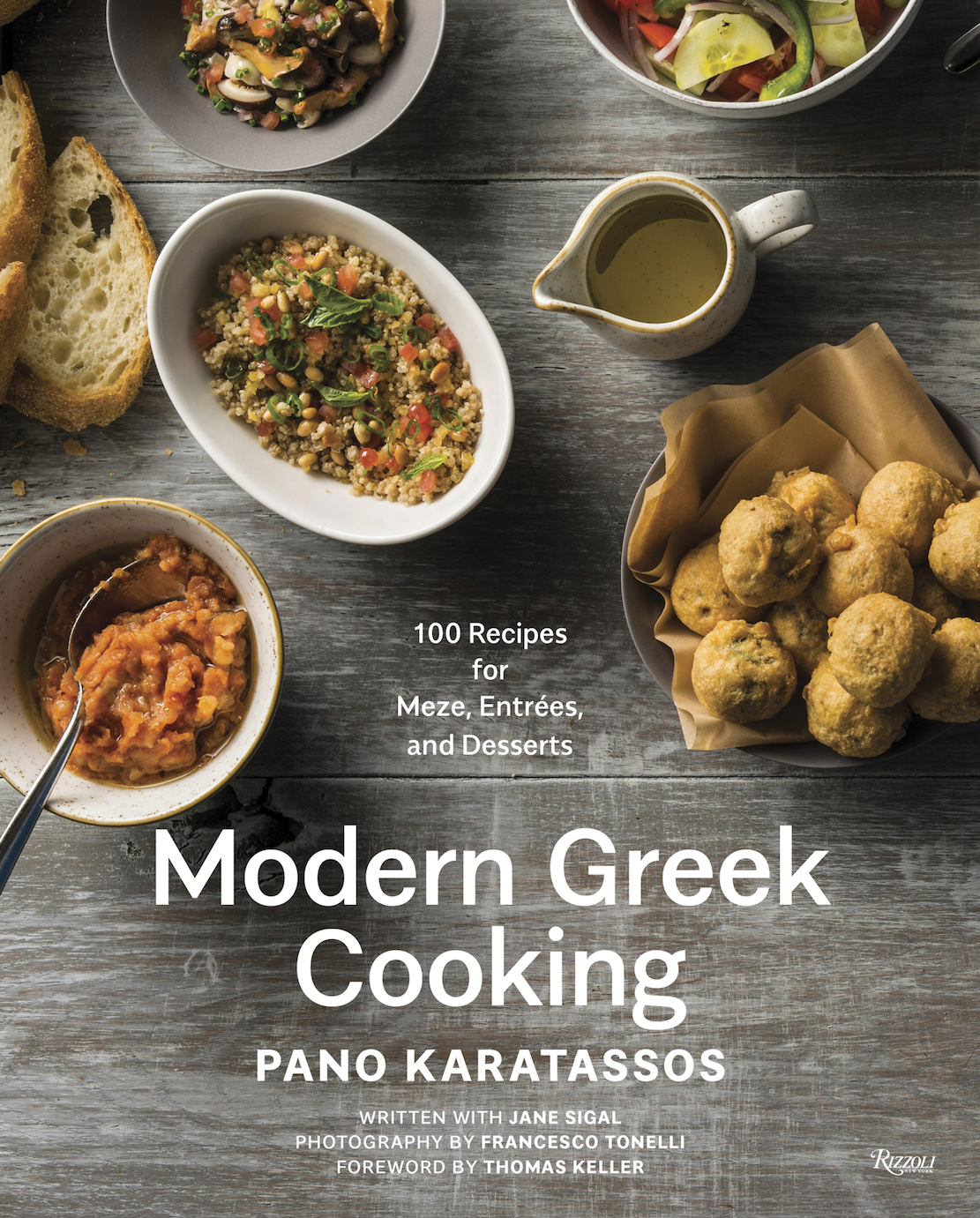 greatest restaurateurs and
practically put Atlanta on the gastro-map with his
restaurants, which includes the wonderful Kyma,
where his son, Pano Jr., oversees the kitchen.
From that long-lived respect for Greek cookery
comes the younger Pano’s excellent new cookbook
that goes way beyond the clichés of Greek food as
found in America. The mezzes,
like coriander-spiced chickpea spread, shirred
eggs with wild mushrooms and tuna tartare with
wild mushrooms and shredded phyllo are stand-outs,
while main courses are simple and easy to make,
like pan-roasted skate with lentils and braised
rabbit with tomato and orzo. Wisely he doesn’t
expect readers to make their own phyllo, but there
is a baklava recipe. He also provides an
up-to-date guide to modern Greek viniculture.
greatest restaurateurs and
practically put Atlanta on the gastro-map with his
restaurants, which includes the wonderful Kyma,
where his son, Pano Jr., oversees the kitchen.
From that long-lived respect for Greek cookery
comes the younger Pano’s excellent new cookbook
that goes way beyond the clichés of Greek food as
found in America. The mezzes,
like coriander-spiced chickpea spread, shirred
eggs with wild mushrooms and tuna tartare with
wild mushrooms and shredded phyllo are stand-outs,
while main courses are simple and easy to make,
like pan-roasted skate with lentils and braised
rabbit with tomato and orzo. Wisely he doesn’t
expect readers to make their own phyllo, but there
is a baklava recipe. He also provides an
up-to-date guide to modern Greek viniculture.
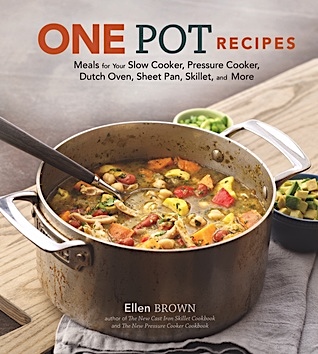
ONE POT RECIPES By Ellen Brown
($25)—Home cooking in America, I’m convinced, is
one percent performance and 99 percent wishful
thinking. I doubt people really have time to cook
several dishes for a single evening, even when
entertaining. This new book by one of my favorite
and most authoritative food writers makes the
realistic and reasonable claim that “Scrubbing up
after a dinner is right up there with having a
root canal without Novocain,” and that her recipes
take one pot, one burner and a minimum of clean-up
time. There is good info on modern pressure
cookers—an outright boon to canny cooks—and the
recipes are thoroughly tested to come out right,
from salmon and rice pilaf with chimichurri sauce
to Caribbean veal stew, from pan-fried gnocchi
with sausage and mushrooms to a Reuben sandwich
casserole with sauerkraut and Swiss cheese.
❖❖❖
LA REINA OF
MEXICAN CUISINE,
PATRICIA
QUINTANA, DIES AT 72
By John Mariani
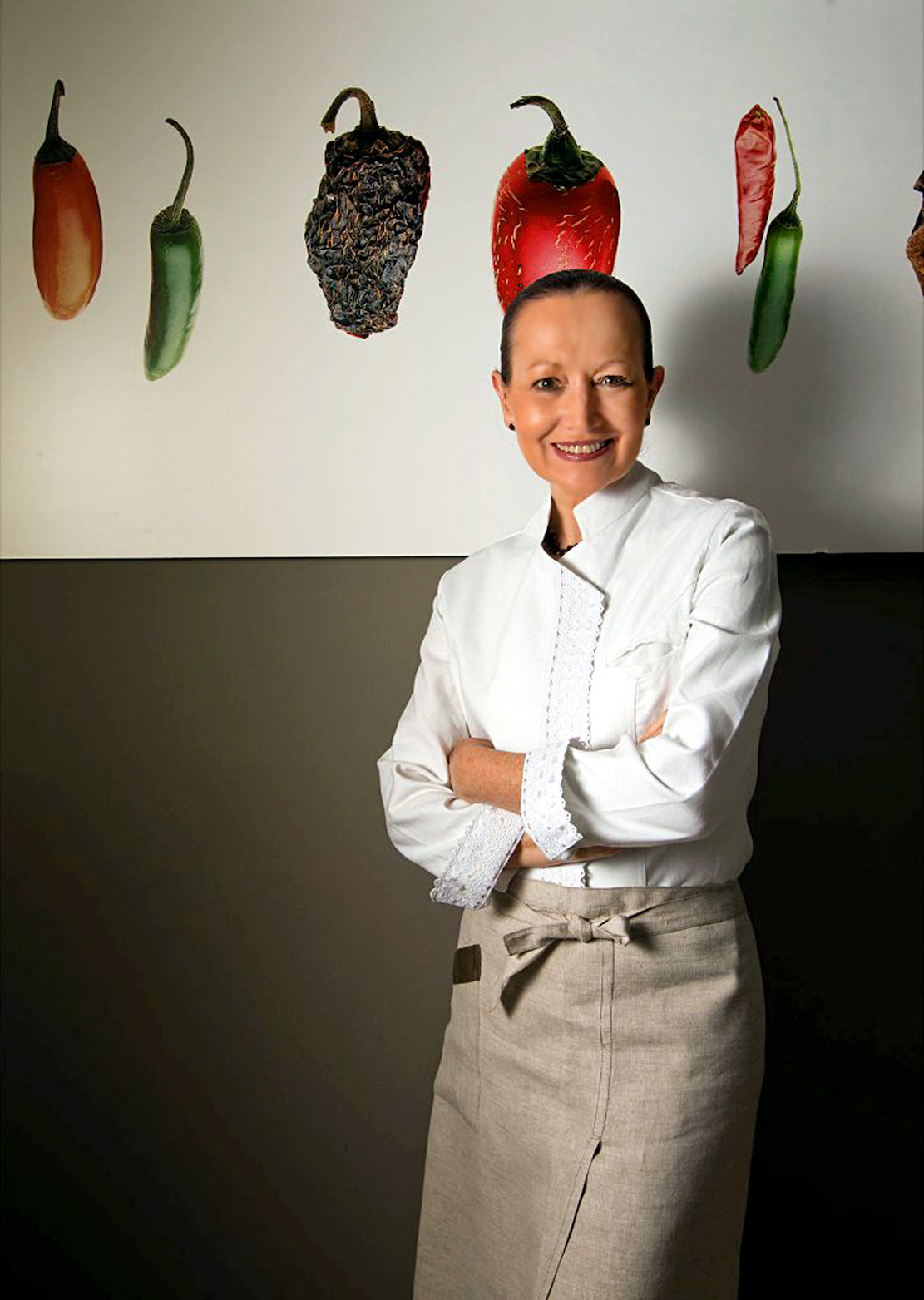 Patricia
Quintana, 72, the chef and author whose work
elevated the image of Mexican cuisine, died last
Monday at her home in Mexico City.
Patricia
Quintana, 72, the chef and author whose work
elevated the image of Mexican cuisine, died last
Monday at her home in Mexico City.
La
Cocina Es un Juego (1979) was her first book and
was followed by 28 books. A prolific
columnist, “Pati” was among the first to ferret
out the varieties, folklore and secrets of
regional cookery of Mexico, and her work was
widely influential, not least in restaurants in
the American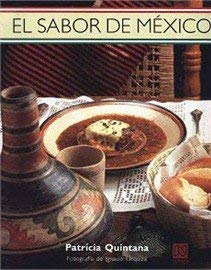 Southwest.
Southwest.
Born in Mexico City, Quintana studied at L’École
Lenôtre in Paris, working with master chefs like
Paul Bocuse and Michel Guérard. When she returned
to Mexico she became one of the country’s very few
acknowledged chefs in a male-dominated profession,
despite the critical presence of women in home
kitchens. The Mexican Ministry of Tourism
appointed her culinary ambassador.
I had great respect for Quintana’s work long before I met her, somewhere in the 1980s, and when I did come to know her I was enchanted with the vitality of the woman, her sheer energy and serious purpose. I dined at her Mexico City restaurant Izote, opened in 2001, which she ran until 2013, when she was diagnosed with non-Hodgkin’s lymphoma, the disease that took her life this week. I’d ask Pati a question and found her to be a walking encyclopedia who speaks and cooks from her heart.
I remember vividly the dishes she sent to the
table that night: little quesadillas filled with huitlacoche and sopacito of refrito beans and four
distinct salsas;
zucchini flowers drifting in a light broth, with
rice and avocado; roast snapper with pumpkin seeds
and strips of mild poblano chilies; a deep dark mole called Chamorro
Revolucionario barbecue, succulent,
deeply flavored pork cooked in a banana leaf.
The flavors of
all these dishes, unlike those in so many Mexican
restaurants both in Mexico itself and north of the
Border, were complex, diverse, never repetitive,
always with textures and underpinnings of spice,
and always very personalized.
Over the course of my travels, I’ve found that
there are chefs I respect, chefs who dazzle me and
chefs I love. The last are very few in number but
Patricia Quintana is at the top of that short
list.
By John Mariani
NY Botanical Garden Train Show
then Lunch on Arthur Avenue
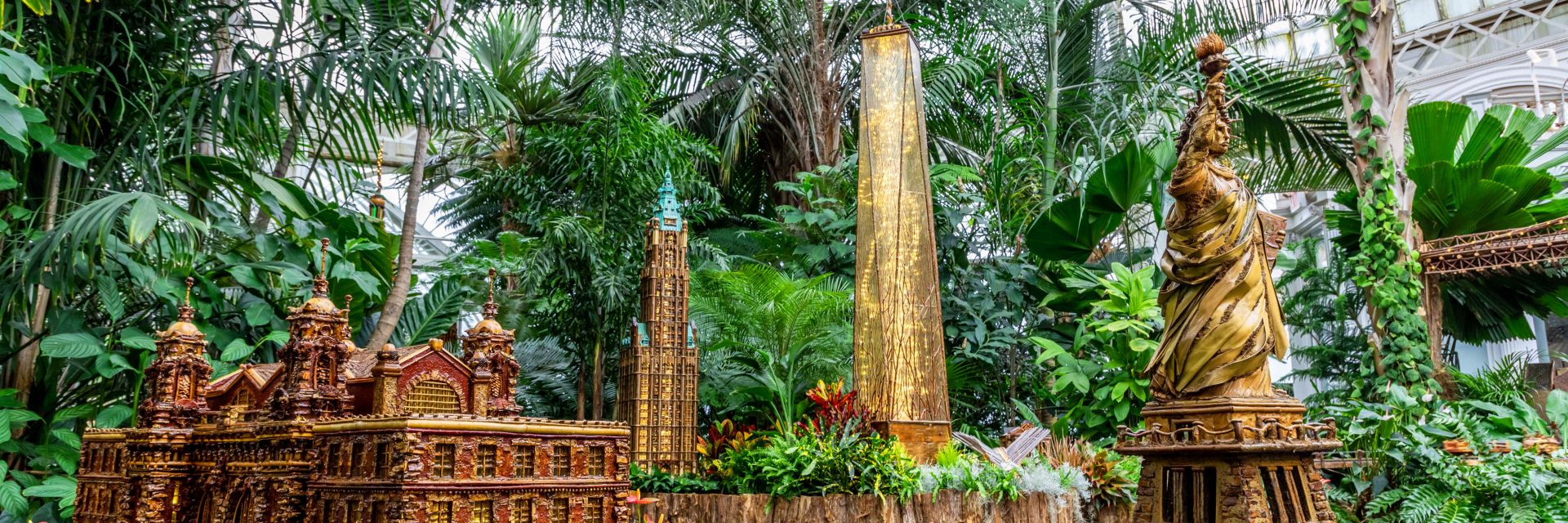
Nowhere in the world are there so many places of international renown during the holidays than in New York, from the Radio City Christmas Spectacular and its Rockettes to the dazzling Rockefeller Center Christmas tree and skating rink, from Macy’s windows to the top of the Empire State Building, where Tom Hanks meets Meg Ryan in “Sleepless in Seattle.”
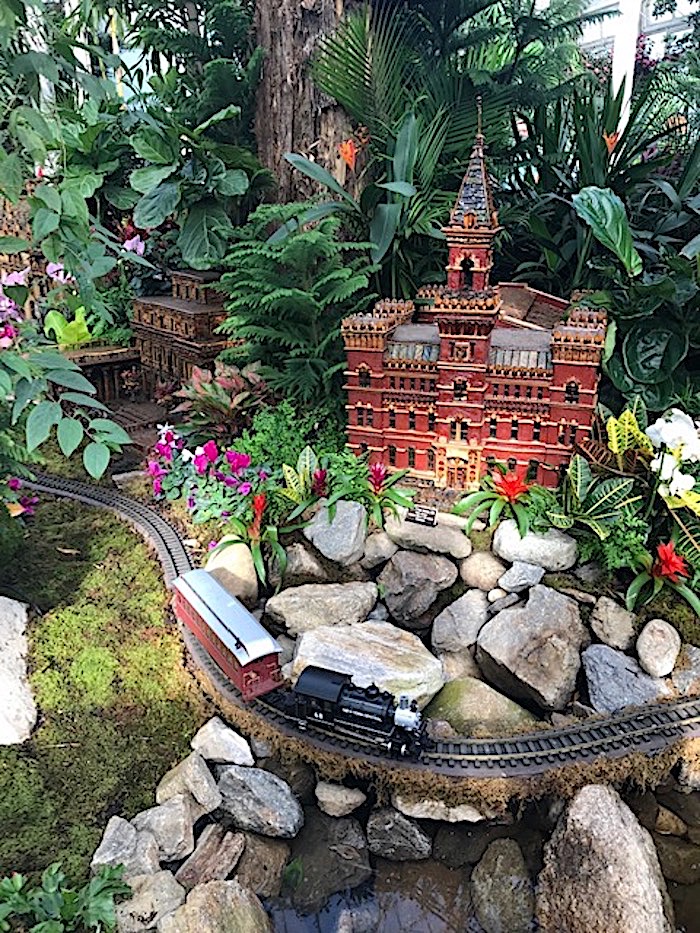 But one of the grandest
sights of all for a family outing is at the New York Botanical
Garden in the Bronx, now holding its 27th
annual Holiday Train Show (through Jan. 21). Set in
the vast Enid A. Haupt Conservatory amidst
thousands of plants and trees, dozens of wonderful
model trains chug beside 175 city landmarks like
the Brooklyn Bridge, Statue of Liberty,
Rockefeller Center, St. Patrick’s Cathedral and
One World Trade Center, as envisioned and created
by Paul Busse and his Applied Imagination company.
All the buildings are constructed from natural
fauna—birch bark, ferns, ivy, lotus pods, acorns
and cinnamon sticks. Children are mesmerized by
the winding trains and trolleys and adults
astonished by the architectural fidelity of the
buildings and the mounting of bridges and trestles
fifteen feet above the ground.
But one of the grandest
sights of all for a family outing is at the New York Botanical
Garden in the Bronx, now holding its 27th
annual Holiday Train Show (through Jan. 21). Set in
the vast Enid A. Haupt Conservatory amidst
thousands of plants and trees, dozens of wonderful
model trains chug beside 175 city landmarks like
the Brooklyn Bridge, Statue of Liberty,
Rockefeller Center, St. Patrick’s Cathedral and
One World Trade Center, as envisioned and created
by Paul Busse and his Applied Imagination company.
All the buildings are constructed from natural
fauna—birch bark, ferns, ivy, lotus pods, acorns
and cinnamon sticks. Children are mesmerized by
the winding trains and trolleys and adults
astonished by the architectural fidelity of the
buildings and the mounting of bridges and trestles
fifteen feet above the ground.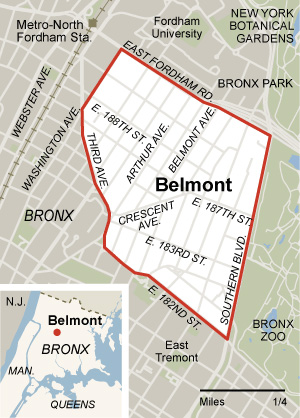
Its popularity is such that entrance is timed to fifteen-minute intervals, and it is wise to book tickets in advance on line. Also, on Bar Car Nights in the Pine Tree Café, adults can enjoy drinks at one of the seasonal bars, gather round fire pits in the Leon Levy Visitor Center, watch ice-sculpting demos and sing along with dueling pianos and roving a cappella groups.
The great thing about the Botanical Garden is its location right across from the Bronx Zoo and adjacent to the Belmont neighborhood of Fordham, a vibrant five-block long Little Italy known as Arthur Avenue. This is where local boy Chazz Palmintieri based the book, movie and Broadway show “A Bronx Tale,” the Bronx of Joe DiMaggio, Phil Rizzuto, Yogi Berra, Jake LaMotta and Julius LaRosa, and where Dion Dimucci and the Belmonts invented doo wop music.
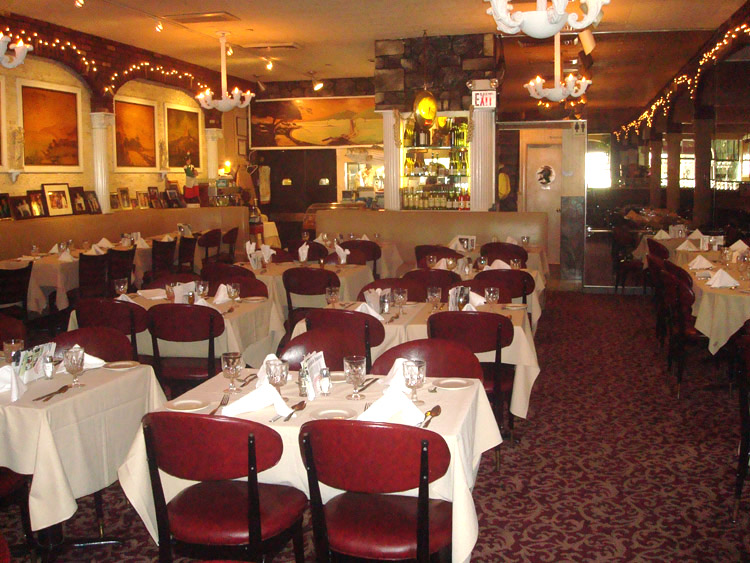 It’s
also where you’ll find some of the most convivial
Italian restaurants in the city. One of the
oldest is Mario’s,
(left)
begun as a pizza window in 1919 and still run by
the fifth generation of the Miglucci family, who
maintain an unwavering consistency, not just with
the nonpareil pizzas but with superb linguine with
clams, tender potato gnocchi in a bright tomato
sauce, and tiny pink lamb chops you pick up by the
bone to eat, called scottaditti,
which means “finger burners.”
It’s
also where you’ll find some of the most convivial
Italian restaurants in the city. One of the
oldest is Mario’s,
(left)
begun as a pizza window in 1919 and still run by
the fifth generation of the Miglucci family, who
maintain an unwavering consistency, not just with
the nonpareil pizzas but with superb linguine with
clams, tender potato gnocchi in a bright tomato
sauce, and tiny pink lamb chops you pick up by the
bone to eat, called scottaditti,
which means “finger burners.”
Across the street is a bright, cheerful trattoria
named San
Gennaro, whose chef-owner Gennaro Martinelli
works outside the traditional 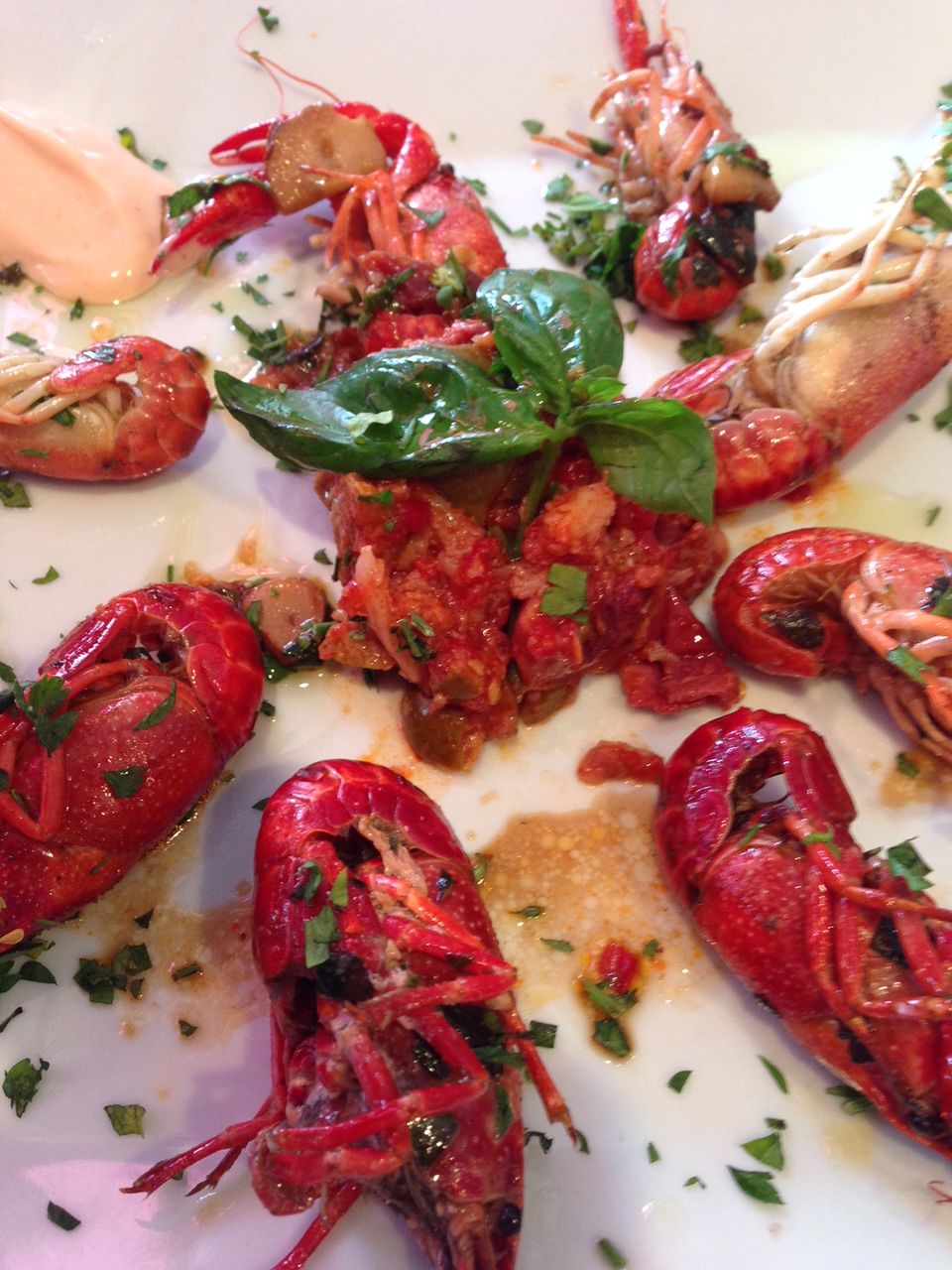 menu with dishes based
on what’s freshest and seasonal in the nearby
markets, so if there are crayfish (right) or
softshell crabs available, you’ll find them there. Housemade
ravioli are graced with a ragù, and
his spaghetti
alla carbonara, with egg heated by the pasta
itself, is textbook perfect.
menu with dishes based
on what’s freshest and seasonal in the nearby
markets, so if there are crayfish (right) or
softshell crabs available, you’ll find them there. Housemade
ravioli are graced with a ragù, and
his spaghetti
alla carbonara, with egg heated by the pasta
itself, is textbook perfect.
I
return often to Tra di Noi,
whose sunny dining room with the requisite
red-checkered tablecloths is the setting for
chef-owner Marco Coletta’s generous, highly
personalized cooking. Regulars ignore the printed
menu in favor of the blackboard specials, which
might include fusilli with
fava beans and rigatoni in a spicy amatriciana
sauce (below).
The osso
buco may be the best in the area.
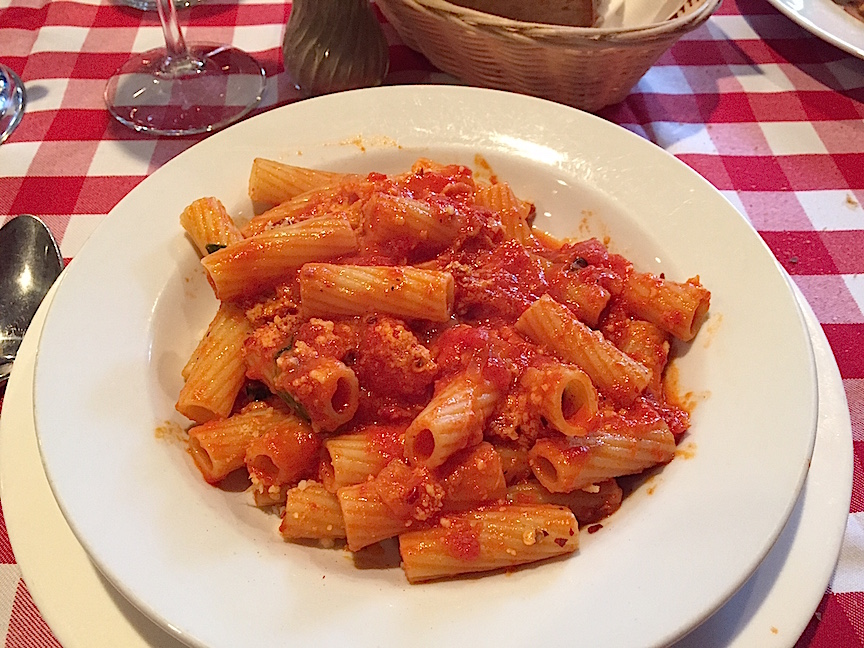 One
of the neighborhood’s culinary pioneers is Roberto
Paciullo, whose namesake trattoria, Roberto’s,
strays from the formulaic to focus on unusual
dishes like tender rabbit braised with tomato and
onions; spaghetti steamed with leeks and porcini mushrooms
in a foil pouch; and fettuccine with parmigiano
and shaved ruffles, all accompanied by the area’s
best wine list.
One
of the neighborhood’s culinary pioneers is Roberto
Paciullo, whose namesake trattoria, Roberto’s,
strays from the formulaic to focus on unusual
dishes like tender rabbit braised with tomato and
onions; spaghetti steamed with leeks and porcini mushrooms
in a foil pouch; and fettuccine with parmigiano
and shaved ruffles, all accompanied by the area’s
best wine list.
Paciullo also owns Zero Otto
Nove (below),
which means “089,” the area code for Salerno, his
hometown in Italy.
He became a local hero on Arthur Avenue
when he demolished a much-despised McDonald’s to
open this shadowy two-story dining room with
corridors that mimic Italy’s narrow streets. He
parks his vintage Fiat 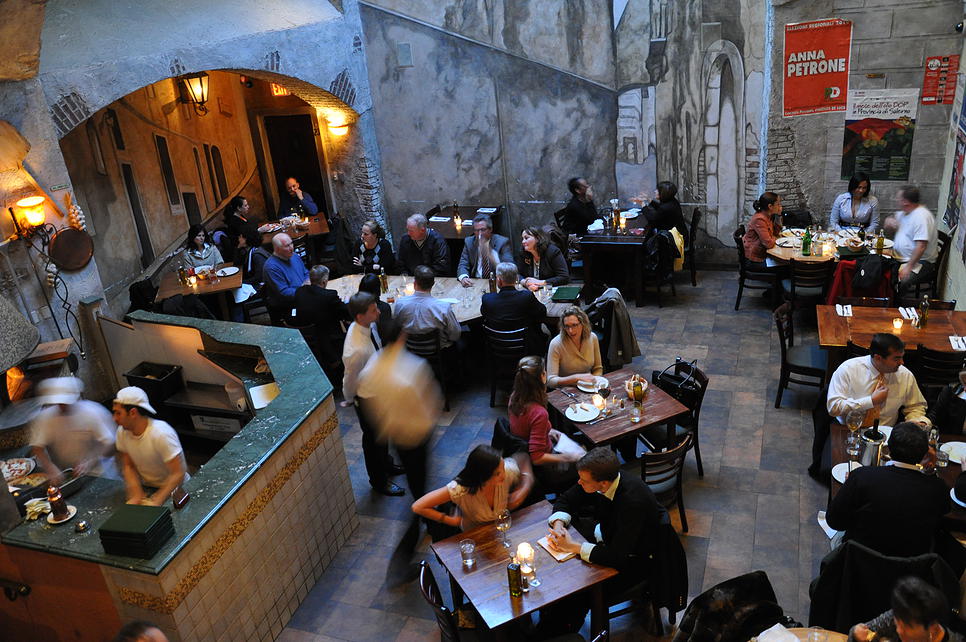 500
outside on the sidewalk.
500
outside on the sidewalk.
The pizzas come in
13 varieties, Salerno-style, with a crispy outer
crust that mellows into a softer crust in the
middle, with toppings like butternut squash puree,
smoked mozzarella, pancetta ham, béchamel sauce and porcini mushrooms.
But the pizzas are only the beginning. There
are also lusty pastas like pasta e
fagioli azzeccata, baked with cannellini
beans and prosciutto, and for dessert a luscious
Nutella pizza.
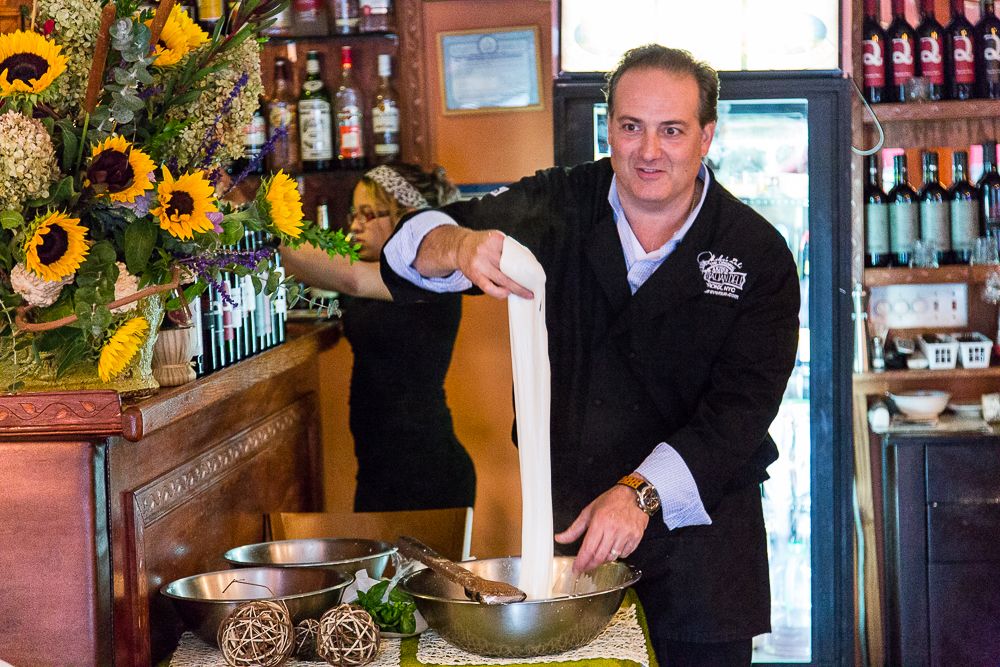 Across
the
street Paciullo runs Fiasco,
another pizzeria, this one serving a thin-crust
style, and the rest of its menu is terrific, too,
from grilled octopus with beans and capers to
lasagna made with short ribs.
Across
the
street Paciullo runs Fiasco,
another pizzeria, this one serving a thin-crust
style, and the rest of its menu is terrific, too,
from grilled octopus with beans and capers to
lasagna made with short ribs.
The
best Italian charcuterie and hero
sandwiches—including an eggplant parmigiana that
beat TV chef Bobby Flay’s in a smackdown—is found
at Mike’s
Deli, located inside the cavernous Arthur
Avenue Retail Market. There the indefatigable
owner, David Greco (left), works the counter,
stocking a daunting array of salami, cheeses,
handmade mozzarella, marinated vegetables and
baked pastas that can be eaten at tables adjacent
to the deli. Greco
also supplies the cheery Bronx Beer
Hall (right) on
the same premises, which proudly serves brews made
at nearby Bronx breweries and is often thronged
with Fordham University students.
Greco
also supplies the cheery Bronx Beer
Hall (right) on
the same premises, which proudly serves brews made
at nearby Bronx breweries and is often thronged
with Fordham University students.
Six days a week all the avenue’s stores are open, selling fresh noodles and ravioli at Bugatti’s, superb seafood at Randazzo’s and Italian treats like panettone Christmas cake at pastry shops on every block. The aromas from the bread stores and cafes in the cold holiday air can make you swoon.
By John Mariani
JOEL GOTT
WINES
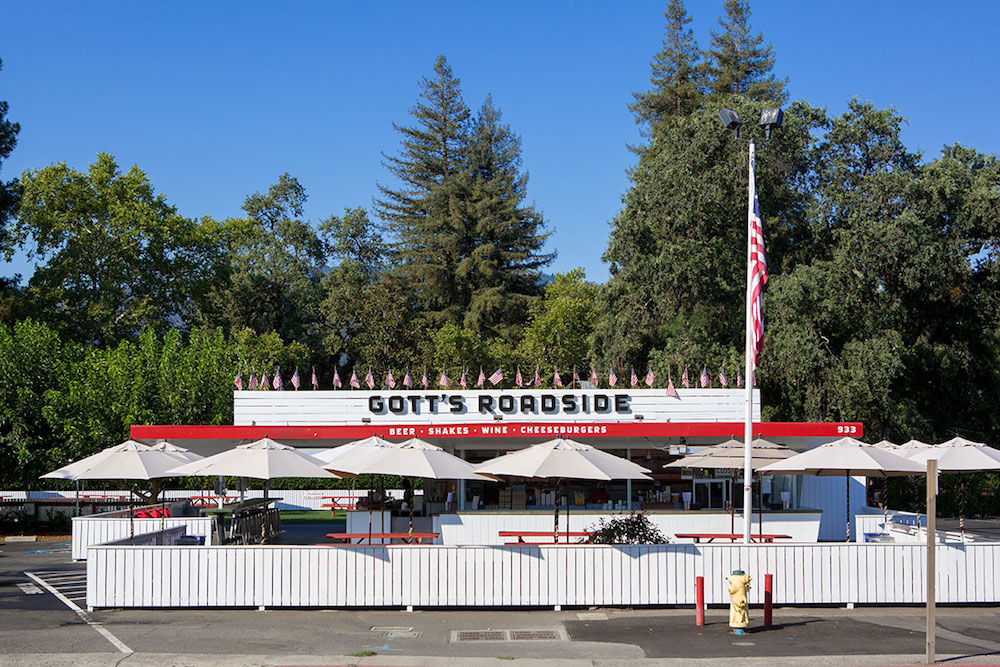
No one driving north on Napa Valley’s Route 128 can miss the old sign that reads Taylor’s Refresher, a roadside stop dating back to 1939. But the occupant of the land is Gott’s Roadside, founded in 1999 by brothers Joel and Duncan Gott, who out of nostalgia kept the old sign everyone knew. The stand is always busy and people know they’re getting an unusually high quality of hamburger, French fries, onion rings and milkshakes, sourced from the best beef, dairies and vegetable purveyors in the state. There are now seven Gott’s Roadside stands (including one at San Francisco International Airport).
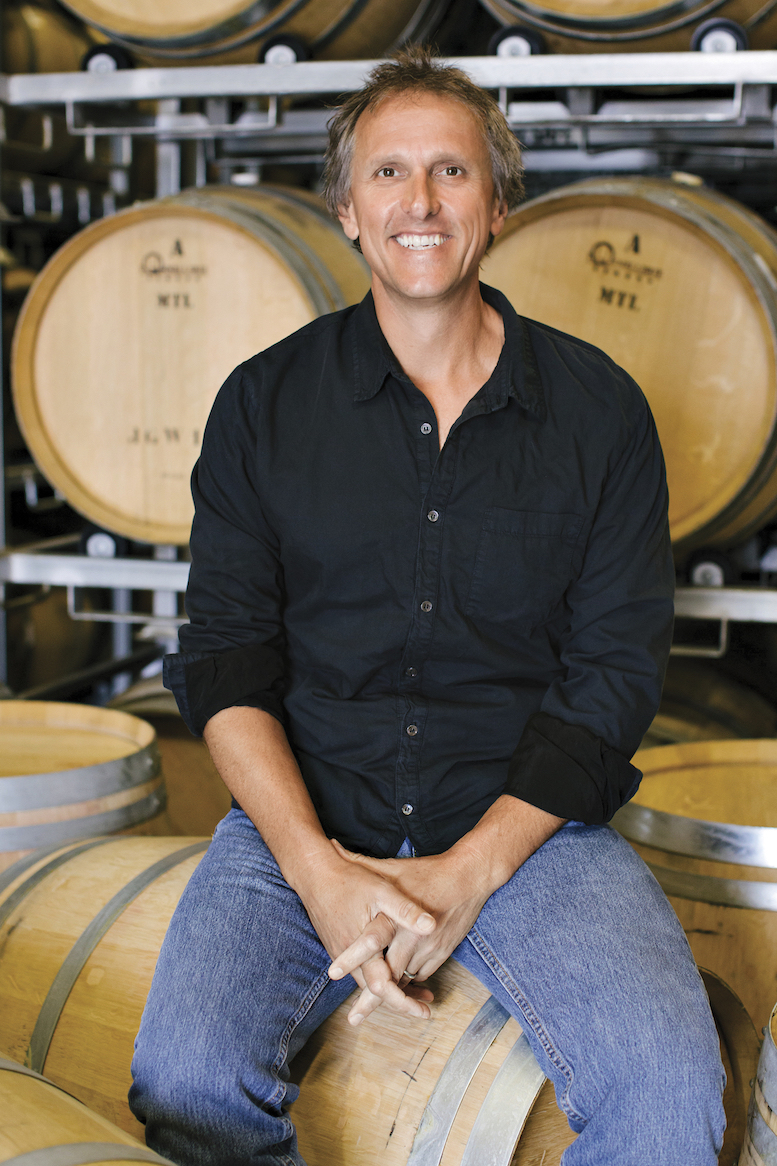 Three
years earlier, Joel Gott, who grew up in the
wine industry, founded his own winery with his
then-girlfriend Sara, buying fruit from the
best growing regions in California, Oregon and
Washington. That is not a unique concept in
western winemaking, but it puts the now
sacrosanct idea of terroir into question.
Three
years earlier, Joel Gott, who grew up in the
wine industry, founded his own winery with his
then-girlfriend Sara, buying fruit from the
best growing regions in California, Oregon and
Washington. That is not a unique concept in
western winemaking, but it puts the now
sacrosanct idea of terroir into question.
Twenty years ago you’d be hard put to find the word “terroir” in an English or American dictionary, though among wine aficionados it has been the go-to word to describe a very large or very small viticultural region with distinctive characteristics of soil and climate. Terroir is a passionate religion to the French, who have been carving up their parcels of land to identify the geological, sometimes mysterious, composition of the soil that gives a particular vineyard’s wines a particular taste.
When the California
wine industry boomed in the 1970s, terroir
still sounded like a foreign idea, not least
because the vineyards of Napa and Sonoma threw
into question how much micro-climates and
levels of limestone and clay really mattered
in a vast region where good wine seemed to
just seep out of the ground. By
the ‘80s, however, terroir was a buzzword for
California wineries, which gave them the more
mundane term “blocks” plus numbers, and
serious viticultural studies out of the
University of California at Davis showed that
there were indeed plots more suitable to
certain varietals than others.
So,
back to Joel Gott, with whom I had dinner at
New York’s new Four Seasons restaurant. Gott
has that amiable California way of talking,
using words like “neat stuff” and describing
how he “feels like I’m six or seven years old
again whenever I look at a yellow and green
tractor.” For
Gott terroir is where you find it, leasing all
his vineyards from nine blocks in California
and the Northwest, “always trying to stay
ahead of the rolling ball.” He has other wineries ferment
some of his bottlings and stores his barrels
at Ranch Winery in Napa.
He
partnered with Roger Scommegna and Charles
Bieler on the Three Thieves brand and in
2005 with the Trinchero Family Estates to
expand his market coverage.
rolling ball.” He has other wineries ferment
some of his bottlings and stores his barrels
at Ranch Winery in Napa.
He
partnered with Roger Scommegna and Charles
Bieler on the Three Thieves brand and in
2005 with the Trinchero Family Estates to
expand his market coverage.
“It’s all this crazy coordination that makes it fun,” he says, working with a small staff of eight. “To me it’s like a Rubik’s Cube: There are a million different options to making the best wine. Ten percent of the choices get screwed up in the winery, and we’ve made some losers. But we ask ourselves, do we want to take a risk in a vineyard we love? For instance, we only make 126 cases of Grüner-Veltliner because we wanted to see if we could make a good one.”
As a result, Gott’s range is very wide, from Rosé of Grenache ($18) and Unoaked Chardonnay ($15) to simply labeled Washington Red Wine ($15) and a best-selling Sauvignon Blanc ($12). Only a few, like his Oregon Pinot Noir ($25) and 14 Cabernet Sauvignon ($53) are priced higher.
Over the course of the dinner we tasted some of Gott’s wines right next to some famous French bottlings, “for fun.” Comparisons showed that while there were differences in flavor, there were far more marked differences in price.
“We want to make wines with acid that go well with food,” he says, “and we want them to taste clean, vibrant. And we keep the price of our wines so that someone who buys a bottle feels he stole something because the wines taste far pricier than they are. We are unique in being up against big companies making brands, not wine.”
Given his success by being unorthodox, I asked if companies and entrepreneurs seek to invest in his winery. “All the time,” he says, “but we have some good bankers who loan us whatever we need. So, I’ll meet a potential investor at Gott’s Roadside and, if he has nothing else to offer but money, I just say, “Thanks very much for coming over. Here’s a milkshake.”
❖❖❖
Wine
Column Sponsored by Banfi Vintners
SANGIOVESE
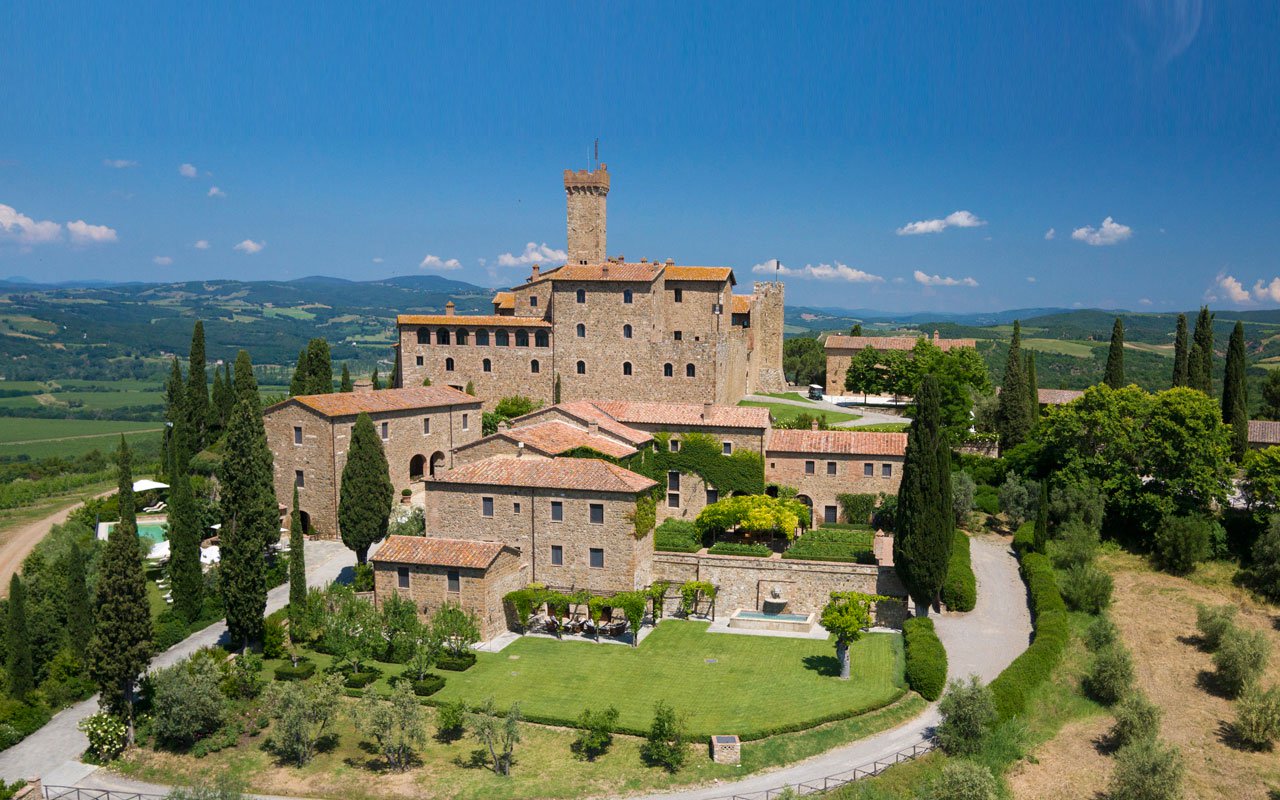 Wine is a joy year-round but
in cooler weather one
grape varietal has really taken center stage in
my daily activities – that most Italian of
grapes, Sangiovese, and its ultimate expression
– Brunello di Montalcino.
Wine is a joy year-round but
in cooler weather one
grape varietal has really taken center stage in
my daily activities – that most Italian of
grapes, Sangiovese, and its ultimate expression
– Brunello di Montalcino.
From mid-September through mid-October,
the Sangiovese grown for our various styles of red
wines are be harvested, culminating with the top
selection for Brunello di Montalcino.
Second, cooler weather here means
it is time to start enjoying more red wines and
especially Sangiovese based wines. That
includes Banfi’s cru of Brunello, Poggio alle Mura,
literally the cream of the crop of our Sangiovese
vineyards. Alongside our Poggio alle Mura Brunello di
Montalcino, this year we introduced two more wines
from the cru Poggio alle Mura – a Rosso di Montalcino
and a Riserva of Brunello. Rosso is sort of like the
younger brother of Brunello, also made from 100%
Sangiovese grapes but usually a selection from younger
vines and the wine is aged only two years compared to
the four required for Brunello. The
Riserva, on the other hand, is an even more selective
harvest of Sangiovese, and ages for an additional year
before release.
What is so special about this cru
Poggio alle Mura?
Well, it is the result our over 30 years of
ongoing research at my family’s vineyard estate,
Castello Banfi.
When we first began planting our vines there in
the late 1970s studies from the University of Bordeaux
indicated which strains of many varietals we should
plant, based on the soil type and microclimate of each
vineyard. But
when it came to the region’s native Sangiovese, there
was only local lore, no scientific research. So we took
it upon ourselves to figure out this vine, and set off
on three decades of incredibly detailed research.
We started
with 600 apparent variations on Sangiovese, because it
is so susceptible to variations in weather and soil,
and narrowed that down to 160 truly genetically
different clones.
We planted a vineyard with two rows of each
type, made wine from each of them, and charted the
differences – remember, you only get one chance a year
to make wine, so this took time.
It took about ten years to get some
concrete results, though we continue to experiment
today and always will – you never stop learning in
science and nature!
Once we determined which were the best,
complementary clones that could be planted together to
make the best Brunello, we chose to plant them in what
we determined to be the optimal vineyard sites. Coincidentally,
the best soils and climate conditions are in the
slopes surrounding the medieval fortress today known
as Castello Banfi, known since Etruscan times as
Poggio alle Mura – the walled hilltop. Hence the
name of our most special “cru” of Brunello,
representing a synthesis between tradition and
innovation.
Though the focus of this study was
our Brunello, all of our Sangiovese-based wines,
including the super Tuscans SummuS, Cum Laude, and
Centine, benefitted from this work. And that’s
the third reason for celebrating Sangiovese this
month, for the range of wonderful reds that usher us
into autumn! One
wine in particular was inspired by our research – the
BelnerO, a Sangiovese dominant blend with what I like
to call a kiss of Cabernet and a whisper of Merlot. We grow the
grapes a little differently for BelnerO than for
Brunello, make the wine with less oak aging and
released it earlier from the winery, providing a
counterpoint to Brunello and a lovely terroir-driven
wine in its own right.
If you
know Italians, you know that by nature we are
multi-faceted, varying in mood, and always passionate. As a
nation, we span from the hot sunny beaches of Sicily
near the African coast to the rugged mountains and
Alpine ski slopes of Trentino-Alto Adige in the north. Sangiovese
is grown in almost all of Italy’s regions and reflects
the unique nature of each; it is most famous
(rightfully so) in Tuscany, yet even there it reflects
the nuances of each hilltop, valley and subzone. It has
something a little different to say in Brunello than
Chianti, Morellino than Vino Nobile di Montepulciano,
Rosso di Montalcino than Super Tuscan blends.
Here is a smattering of
Sangiovese-based wines that you may wish to get to
know better, reflecting a spectrum that appeals to
every occasion, every taste, and every budget. We can
assure you that the conversation will never become
boring. 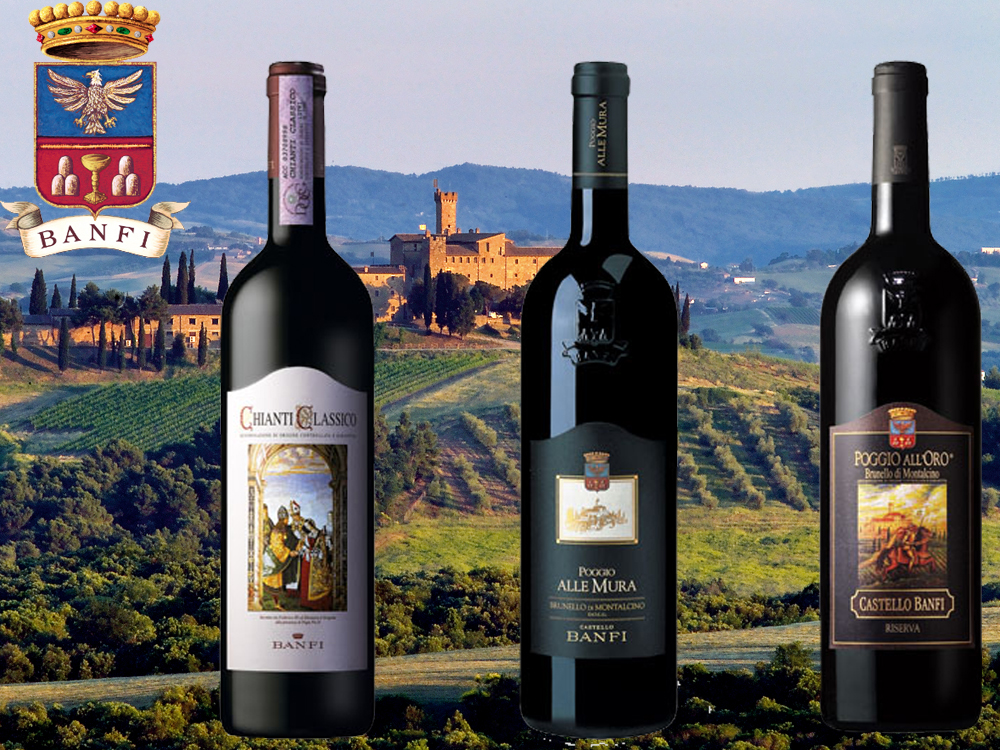
Recommendations for Celebrating
Sangiovese
BelnerO Proprietor’s Reserve Sangiovese
– A refined
cuvée of noble red grapes perfected by our pioneering
clonal research. This dark beauty, BelnerO, is
produced at our innovative winery, chosen 11
consecutive years as Italy’s Premier Vineyard Estate.
Fermented in our patented temperature controlled
French oak and aged approximately 2 additional years.
Unfiltered, and Nitrogen bottled to minimize sulfites.
Castello Banfi Brunello di Montalcino –
Rich, round, velvety and intensely
aromatic, with flavor hints of licorice, cherry, and
spices. Brunello di Montalcino possesses an intense
ruby-red color, and a depth, complexity and opulence
that is softened by an elegant, lingering aftertaste.
Unfiltered after 1998 vintage.
Castello Banfi Rosso di Montalcino – Brunello's "younger brother," produced
from select Sangiovese grapes and aged in barrique for
10 to 12 months. Deep ruby-red, elegant, vibrant,
well-balanced and stylish with a dry velvety
finish.
Poggio all’Oro Brunello di Montalcino
Riserva – A single vineyard selection of our most
historically outstanding Sangiovese, aged five years
before release, the additional year more than that
required of Brunello including 6 months in barrel and
6 months more in bottle to grant its “Riserva”
designation. Incredible
elegance and harmony. Intense with lots of fruit and
subtle wood influence. Round, complete, well balanced
with hints of chocolate and berries. Unfiltered after
1998.
Poggio alle Mura – The first tangible result of years of
intensive clonal research on Montalcino’s native
Sangiovese grape.
Estate bottled from the splendidly sun drenched
vineyards surrounding the medieval Castello from which
it takes its name.
The Brunello
di Montalcino is seductive, silky and smoky. Deep ruby
in color with an expressive bouquet of violets, fruits
and berries as well as cigar box, cedar and exotic
spices. The Rosso
di Montalcino is also intense ruby red. The bouquet
is fresh and fruity with typical varietal notes of
cherry and blackberry, enriched by more complex hints
of licorice, tobacco and hazelnut. It is full
bodied, yet with a soft structure, and a surprisingly
long finish. The Poggio alle Mura Brunello di Montalcino
Riserva is deep ruby red with garnet
reflections and a rich, ample bouquet that hints of
prune jam, coffee, cacao and a light balsamic note. It is full
and powerful, with ripe and gentle tannins that make
it velvety and harmonious; this wine is supported by a
pleasing minerality that to me speaks soundly of that
special hillside in southern Montalcino.
SummuS – A wine of towering elegance, SummuS is an
extraordinary blend of Sangiovese which contributes
body; Cabernet Sauvignon for fruit and structure; and
Syrah for elegance, character and a fruity bouquet. An elegant,
complex and harmonious red wine.
Cum Laude – A complex and elegant red which graduated
“With Honors,” characterized by aromas of juicy
berries and fresh spices.
Centine – A Cuvee that is more than half
Sangiovese, the balanced consisting of equal parts of
Cabernet Sauvignon and Merlot. Vinified in
a firm, round style that easily accompanies a wide
range of dishes, this is a smooth and fragrantly
satisfying wine with international character, and a
perennial favorite at my own dinner table.
Banfi Chianti Superiore – The “Superiore” designation signifies
stricter government regulations regarding production
and aging requirements, as compared to regular
Chianti. An
intense ruby red wine with fruit forward aromas and
floral notes. This
is a round wine with well-balanced acidity and fruit.
Banfi Chianti Classico – An enduring classic: alluring
bouquet of black fruit and violets; rich flavors of
cherry and leather; supple tannins and good acidity
for dining.
Banfi Chianti Classico Riserva – Produced from select grapes grown in the
"Classico" region of Chianti, this dry, fruity and
well-balanced red has a full bouquet reminiscent of
violets.
Fonte alla Selva Chianti Classico – This is our newest entry into the Chianti
arena, coming from a 99 acre estate in Castellina, the
heart of the Chianti Classico region. The wine is
a captivating mauve red that smells of cherry, plum
and blackberry with hints of spice. It is
round, full and balanced with very good
acidity.
Col di Sasso – Sangiovese and Cabernet Sauvignon. Luscious,
complex and soft with persistent notes of fruit and
great Italian style structure.
Any of John Mariani's books below may be ordered from amazon.com.
 The Hound in Heaven
(21st Century Lion Books) is a novella, and
for anyone who loves dogs, Christmas, romance,
inspiration, even the supernatural, I hope you'll find
this to be a treasured favorite. The story
concerns how, after a New England teacher, his wife and
their two daughters adopt a stray puppy found in their
barn in northern Maine, their lives seem full of promise.
But when tragedy strikes, their wonderful dog Lazarus and
the spirit of Christmas are the only things that may bring
his master back from the edge of despair.
The Hound in Heaven
(21st Century Lion Books) is a novella, and
for anyone who loves dogs, Christmas, romance,
inspiration, even the supernatural, I hope you'll find
this to be a treasured favorite. The story
concerns how, after a New England teacher, his wife and
their two daughters adopt a stray puppy found in their
barn in northern Maine, their lives seem full of promise.
But when tragedy strikes, their wonderful dog Lazarus and
the spirit of Christmas are the only things that may bring
his master back from the edge of despair. WATCH THE VIDEO!
“What a huge surprise turn this story took! I was completely stunned! I truly enjoyed this book and its message.” – Actress Ali MacGraw
“He had me at Page One. The amount of heart, human insight, soul searching, and deft literary strength that John Mariani pours into this airtight novella is vertigo-inducing. Perhaps ‘wow’ would be the best comment.” – James Dalessandro, author of Bohemian Heart and 1906.
“John Mariani’s Hound in Heaven starts with a well-painted portrayal of an American family, along with the requisite dog. A surprise event flips the action of the novel and captures us for a voyage leading to a hopeful and heart-warming message. A page turning, one sitting read, it’s the perfect antidote for the winter and promotion of holiday celebration.” – Ann Pearlman, author of The Christmas Cookie Club and A Gift for my Sister.
“John Mariani’s concise, achingly beautiful novella pulls a literary rabbit out of a hat – a mash-up of the cosmic and the intimate, the tragic and the heart-warming – a Christmas tale for all ages, and all faiths. Read it to your children, read it to yourself… but read it. Early and often. Highly recommended.” – Jay Bonansinga, New York Times bestselling author of Pinkerton’s War, The Sinking of The Eastland, and The Walking Dead: The Road To Woodbury.
“Amazing things happen when you open your heart to an animal. The Hound in Heaven delivers a powerful story of healing that is forged in the spiritual relationship between a man and his best friend. The book brings a message of hope that can enrich our images of family, love, and loss.” – Dr. Barbara Royal, author of The Royal Treatment.
 |
The Encyclopedia of American Food and Drink by John F. Mariani (Bloomsbury USA, $35) Modesty forbids me to praise my own new book, but let me proudly say that it is an extensive revision of the 4th edition that appeared more than a decade ago, before locavores, molecular cuisine, modernist cuisine, the Food Network and so much more, now included. Word origins have been completely updated, as have per capita consumption and production stats. Most important, for the first time since publication in the 1980s, the book includes more than 100 biographies of Americans who have changed the way we cook, eat and drink -- from Fannie Farmer and Julia Child to Robert Mondavi and Thomas Keller. "This book is amazing! It has entries for everything from `abalone' to `zwieback,' plus more than 500 recipes for classic American dishes and drinks."--Devra First, The Boston Globe. "Much needed in any kitchen library."--Bon Appetit. |
"Eating Italian will never be the same after reading John Mariani's entertaining and savory gastronomical history of the cuisine of Italy and how it won over appetites worldwide. . . . This book is such a tasteful narrative that it will literally make you hungry for Italian food and arouse your appetite for gastronomical history."--Don Oldenburg, USA Today. "Italian
restaurants--some good, some glitzy--far
outnumber their French rivals. Many of
these establishments are zestfully described
in How Italian Food Conquered the World, an
entertaining and fact-filled chronicle by
food-and-wine correspondent John F.
Mariani."--Aram Bakshian Jr., Wall Street
Journal.
"Equal parts
history, sociology, gastronomy, and just
plain fun, How Italian Food Conquered the
World tells the captivating and delicious
story of the (let's face it) everybody's
favorite cuisine with clarity, verve and
more than one surprise."--Colman Andrews,
editorial director of The Daily
Meal.com. "A fantastic and fascinating
read, covering everything from the influence
of Venice's spice trade to the impact of
Italian immigrants in America and the
evolution of alta cucina. This book will
serve as a terrific resource to anyone
interested in the real story of Italian
food."--Mary Ann Esposito, host of PBS-TV's
Ciao
Italia. "John Mariani has written the
definitive history of how Italians won their
way into our hearts, minds, and
stomachs. It's a story of pleasure over
pomp and taste over technique."--Danny Meyer,
owner of NYC restaurants Union Square
Cafe, The Modern, and Maialino.
|
 |
 |
 |
 |
 |
 |
 |
 |
 Everett Potter's Travel Report:
Everett Potter's Travel Report: 
 Eating Las Vegas
JOHN CURTAS has been covering the Las Vegas
food and restaurant scene since 1995. He is
the co-author of EATING LAS VEGAS – The 50
Essential Restaurants (as well as
the author of the Eating Las Vegas web site: www.eatinglasvegas.
He can also be seen every Friday morning as
the “resident foodie” for Wake Up With the
Wagners on KSNV TV (NBC) Channel 3 in
Las Vegas.
Eating Las Vegas
JOHN CURTAS has been covering the Las Vegas
food and restaurant scene since 1995. He is
the co-author of EATING LAS VEGAS – The 50
Essential Restaurants (as well as
the author of the Eating Las Vegas web site: www.eatinglasvegas.
He can also be seen every Friday morning as
the “resident foodie” for Wake Up With the
Wagners on KSNV TV (NBC) Channel 3 in
Las Vegas.
MARIANI'S VIRTUAL GOURMET
NEWSLETTER is published weekly. Publisher: John Mariani. Editor: Walter Bagley. Contributing Writers: Christopher Mariani,
Robert Mariani, Misha Mariani, John A. Curtas, Gerry Dawes, Geoff Kalish,
and Brian Freedman. Contributing
Photographer: Galina Dargery. Technical
Advisor: Gerry
McLoughlin.
If you wish to subscribe to this
newsletter, please click here: http://www.johnmariani.com/subscribe/index.html
© copyright John Mariani 2017

